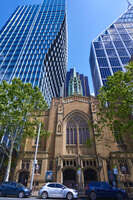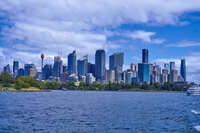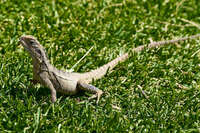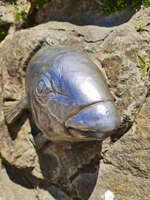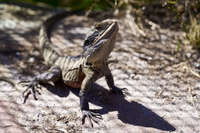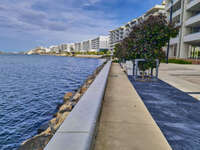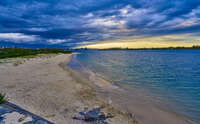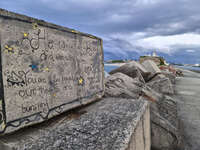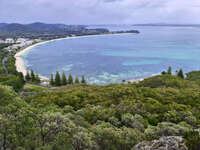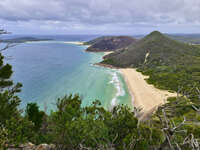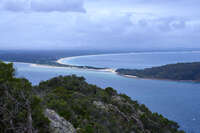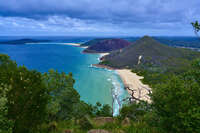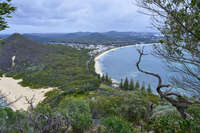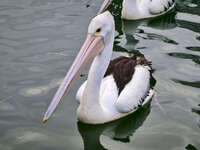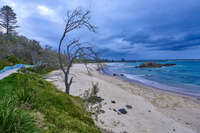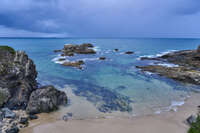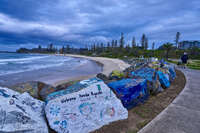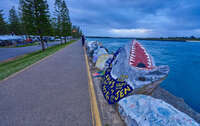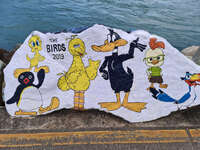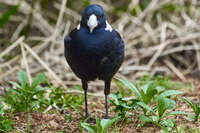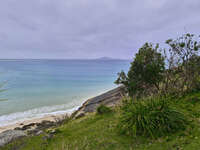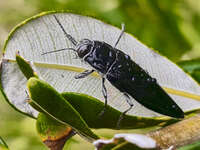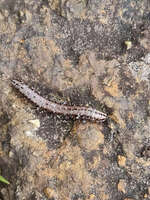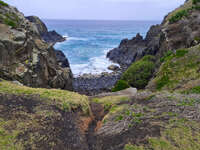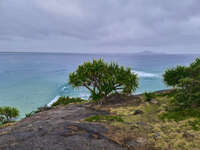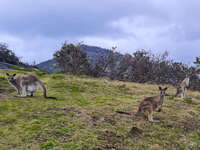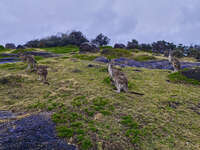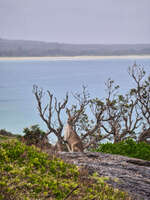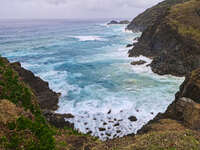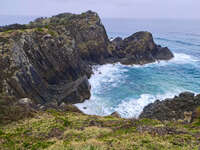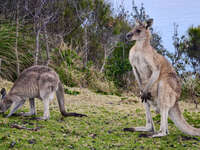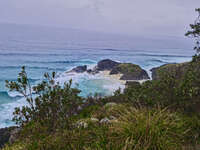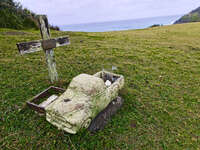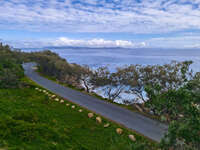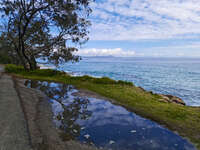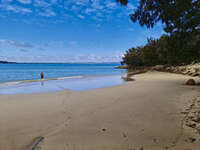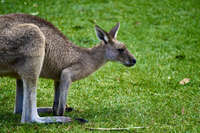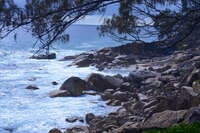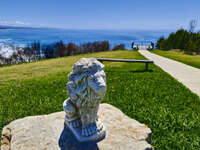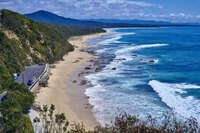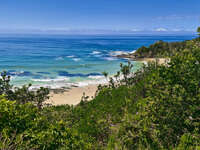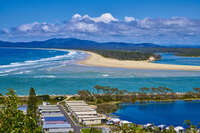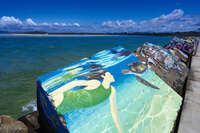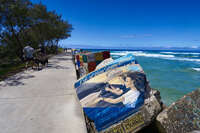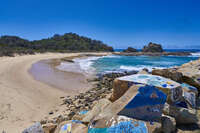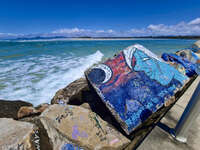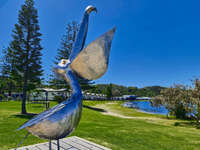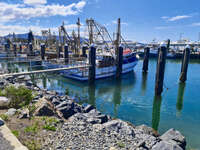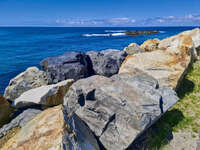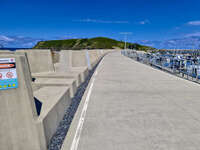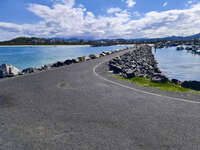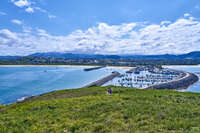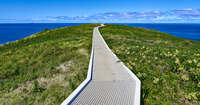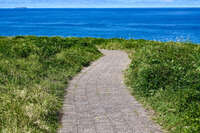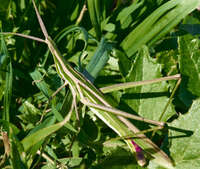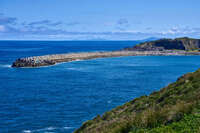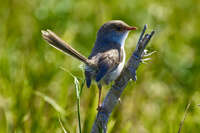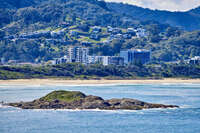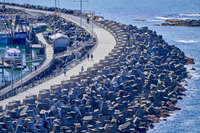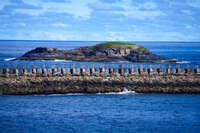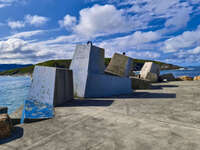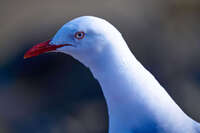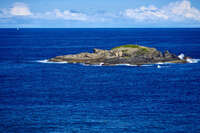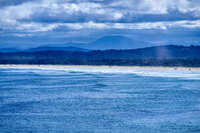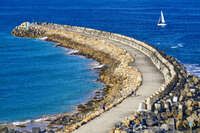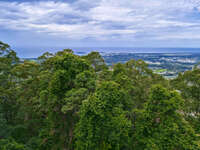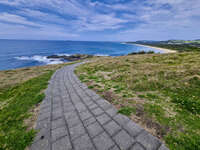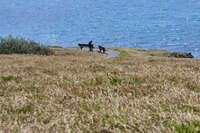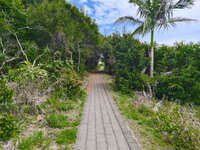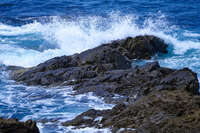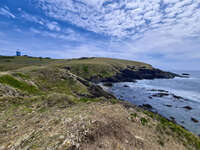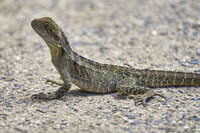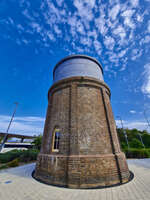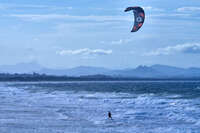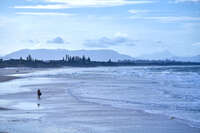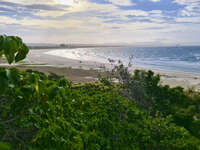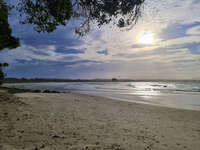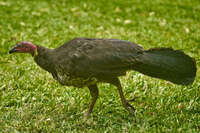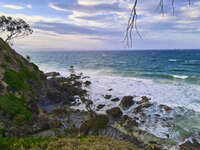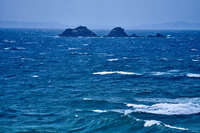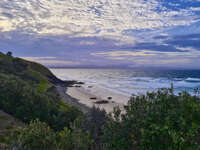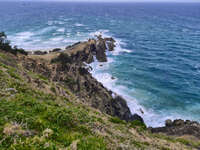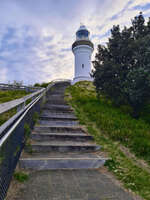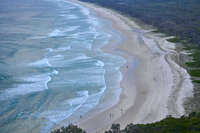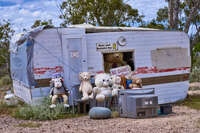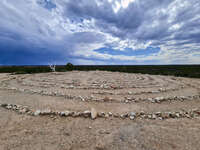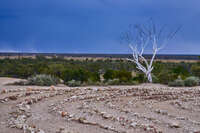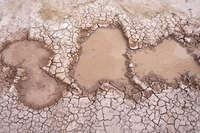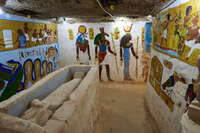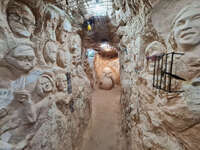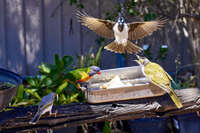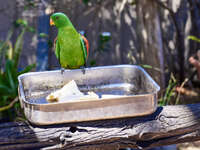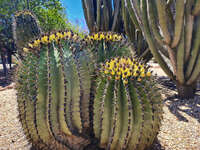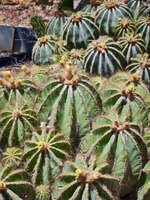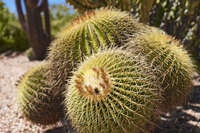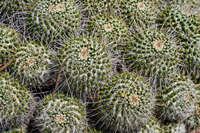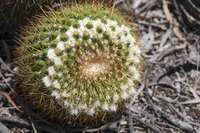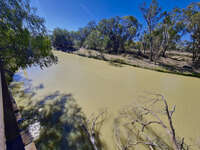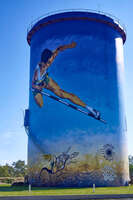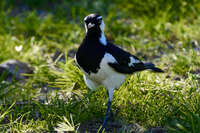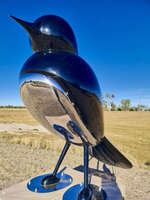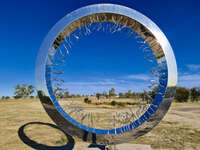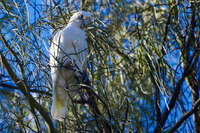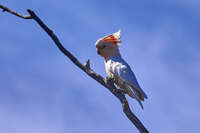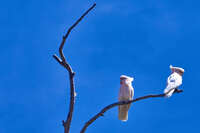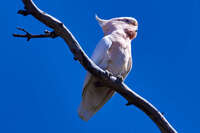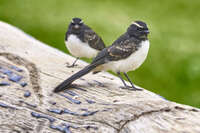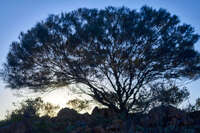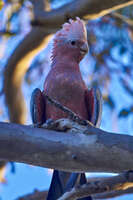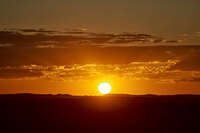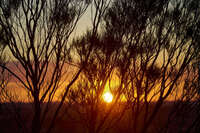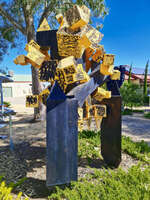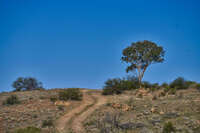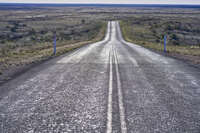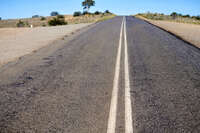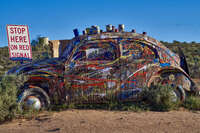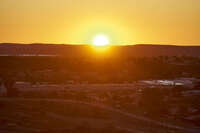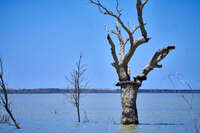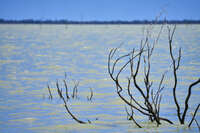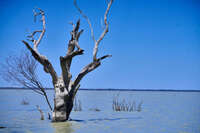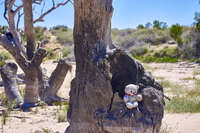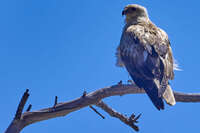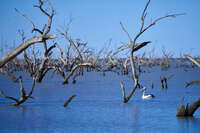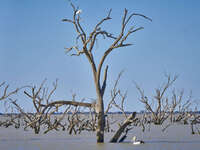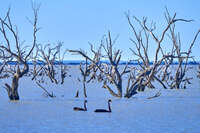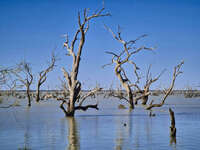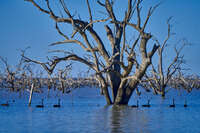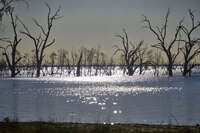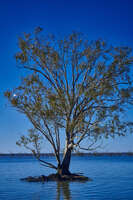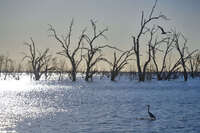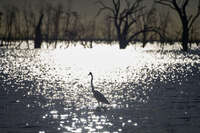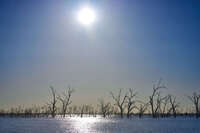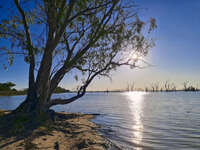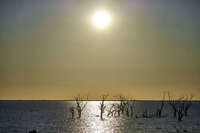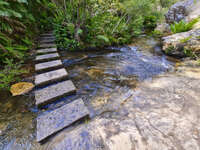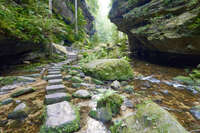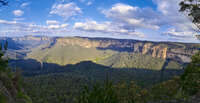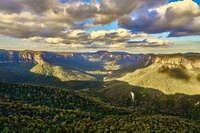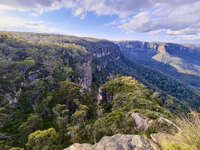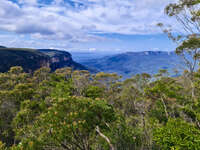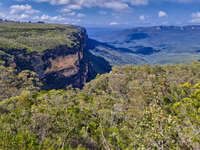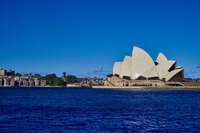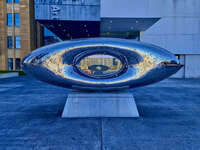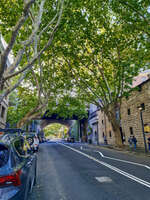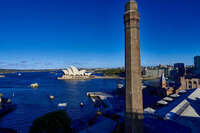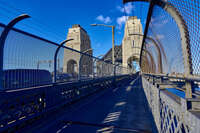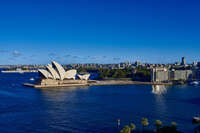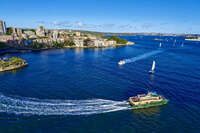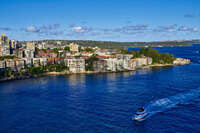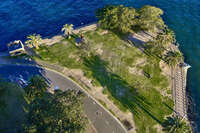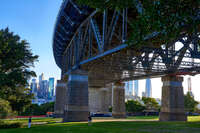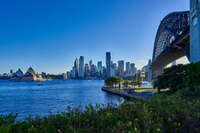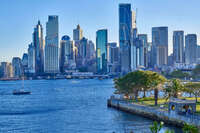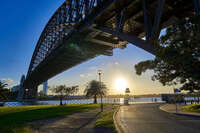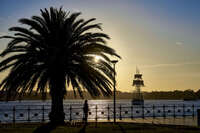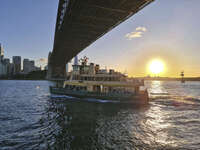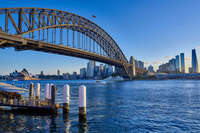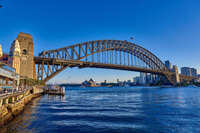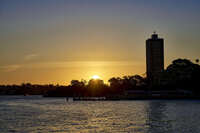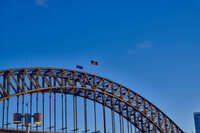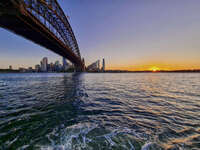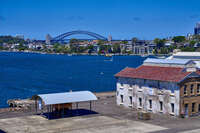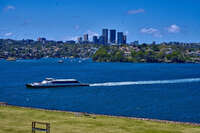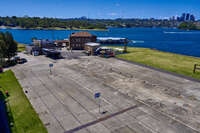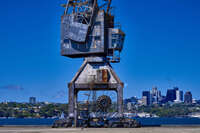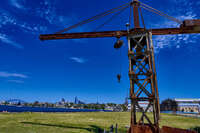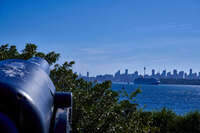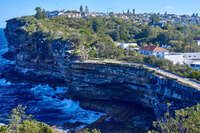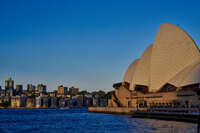NSW
When old meets new, the skyline gets confused.
The air seemed to shimmer with contrasts as I stood before this sandstone relic of faith. Its pointed arches and intricate carvings spoke of a time when craftsmanship was worshipped as much as the divine. Yet here it stood, flanked by towering glass monoliths that seemed to stretch endlessly into the azure sky. The trees lining the street offered an almost apologetic shade, their leaves rustling faintly against the hum of passing cars. The scene felt like a conversation between centuries—one whispering hymns, the other humming algorithms. I lingered longer than I intended, caught in the quiet dialogue between stone and steel.
Looks like the bridge and opera house are competing for attention!
The sails seemed to ripple against the sky as if caught in an invisible wind. Below them, water lapped gently at the edges of the quay, carrying faint echoes of laughter and distant music. I turned my gaze to the Harbour Bridge, its steel frame stretching like an iron rainbow over the bay. There was something humbling about standing between these two giants—one a celebration of art and creativity, the other a triumph of engineering grit. As I walked closer to the water's edge, I noticed how the sunlight danced on its surface, creating fleeting patterns that felt as alive as the city itself. It’s moments like these that remind you how human hands can shape beauty from stone and steel.
Do you think skyscrapers ever get vertigo?
The skyline stretched before me like a symphony of glass and steel. Each building seemed to vie for attention, reflecting sunlight in a way that felt both chaotic and harmonious. The water below rippled gently as a yacht passed by, its wake creating fleeting patterns on the surface. I paused to take it all in—the contrast between nature’s stillness and the city’s restless ambition. A flock of seagulls hovered nearby, their cries punctuating the distant hum of urban life. It struck me how this view was both imposing and strangely tranquil, as if the city itself had learned to coexist with its surroundings.
This lizard clearly skipped its leg day workout.
A rustle in the grass caught my eye. There it was—a lizard frozen mid-stride as though debating whether I was friend or foe. Its eyes glinted in the sunlight, and its tail seemed to stretch endlessly behind it. I crouched down to observe it more closely, marveling at how its textured skin mirrored the earth tones around it. The simplicity of this moment felt oddly profound—just a creature existing in its element while the world rushed by. Nearby, children’s laughter echoed faintly from a park bench, but for me, time seemed to pause under the lizard's watchful gaze.
This fish looks like it’s swimming through stone.
A few steps further along the path, I came across another piece of artistry—a metal fish seemingly frozen mid-leap from its rocky perch. Its metallic sheen caught the sunlight and reflected it in sharp bursts, as though it had just emerged from water. The craftsmanship was striking; every scale and fin seemed alive despite its static form. I couldn’t help but admire how seamlessly this piece blended into its natural surroundings. The rock it rested on bore mossy patches that softened its edges, creating a perfect harmony between man-made art and nature’s canvas. In the distance, the faint sound of waves crashing against the shore added an almost cinematic backdrop to this quiet moment.
This lizard looks like it’s plotting world domination.
As I meandered further along the sandy trail, I nearly stepped on a sunbathing lizard. It didn’t flinch—its confidence was almost regal as it stood there, motionless yet exuding a quiet defiance. The sunlight highlighted the intricate patterns of its scales, each ridge and groove telling a tale of survival. Its eyes followed my every move with an intensity that made me feel like the intruder. Around us, the dry vegetation rustled faintly in the breeze, adding to the stillness of the moment. It struck me how even something so small could command such presence amidst an overwhelming landscape. I crouched down to take a closer look, marveling at its effortless blend into this sunlit world.
This pathway looks like it’s leading straight to tranquility.
The promenade stretched ahead like a promise of calm. On one side, the water glimmered under the soft afternoon sun while the other side showcased sleek apartment buildings that seemed to rise effortlessly into the sky. A gentle breeze carried the faint scent of saltwater and freshly planted greenery. I paused by a tree whose leaves rustled quietly as though whispering secrets to the passing wind. The rocks along the water's edge formed a natural boundary that contrasted beautifully with the clean lines of the pavement. It felt as if this space was designed not just for walking but for reflecting—a meeting point where urban precision met nature’s gentle chaos.
This beach looks like it’s practicing social distancing.
The sand curved gently along the water’s edge as though it had been sculpted by a patient hand. The clouds above moved slowly, their dark tones contrasting with the golden light that lingered stubbornly on the horizon. I stood for a moment where the sand met the water, letting the cool breeze carry whispers of distant waves. A lone piece of driftwood lay half-buried near my feet, its edges worn smooth by time. Across the water, faint outlines of trees and city structures seemed to float in a hazy stillness. It was a scene that felt alive yet unhurried—a place where nature’s rhythm dictated time.
Even the storm paused to read the heartfelt words.
A painted block caught my eye as I walked along the uneven surface of the breakwater. It wasn’t just paint—it was a story. The name 'Heidi' stood out among stars and swirls, accompanied by words that seemed to echo louder than the waves crashing below. Whoever wrote it poured their heart onto this concrete canvas. I felt like an intruder in this moment of intimacy yet couldn’t look away. The sky above mirrored the weight of the words—heavy and gray but somehow alive. In the distance, Nobbys Head Lighthouse stood unmoved by time or sentiment, a stoic witness to all these fleeting human gestures. I lingered for a moment longer before moving on, leaving behind this quiet testament to love and loss.
The lighthouse seems to be saying, 'I’ll hold the fort while you run!'
The path stretched ahead like a ribbon of defiance between land and sea. Each step on the breakwater brought me closer to the lighthouse—its white facade unwavering against the churning sky. The air was thick with the scent of salt and impending rain. A few figures moved ahead of me, their silhouettes framed by the brooding horizon. I wondered what drew them here: was it curiosity? Solitude? Or perhaps just a fleeting need to escape? The lighthouse seemed indifferent to our presence, its purpose unchanging as it stood guard over this restless edge of the world. I paused midway to watch the waves crash against the rocks below, their rhythm both chaotic and strangely soothing. It felt like standing in a moment suspended between calm and storm.
The plants seem to be gossiping about the weather.
The view from Lily Hill was like stepping into a quiet conversation between land and sea. The vegetation at my feet seemed untouched by time—wild and free—while the bay stretched out below like a mirror reflecting the subdued hues of the sky. The islands in the distance appeared as if they were drifting slowly away, reluctant to leave the embrace of the water. I thought about how landscapes like this carry their own rhythm, one that doesn’t rush or falter but simply exists. It made me wish I could match its tempo for just a moment longer.
The water's so clear it feels like the sky forgot to finish painting it.
From this height, Shoal Bay unfolded like an artist’s canvas—each stroke deliberate yet effortless. The beach curved gently along the water’s edge, a ribbon of sand that seemed to hold the bay in place. Below me, the vegetation was alive with whispers of wind and life, while the water sparkled faintly under the muted light. I traced the patches of darker blue where seagrass or coral might be hiding, their presence adding depth to an already intricate scene. Farther out, the hills and islands stood like sentinels guarding this quiet expanse. It felt as though the bay had been waiting for centuries just to be seen like this.
The hills look like they’ve been napping for centuries.
The hills seemed ancient yet unbothered by the passage of time. Their slopes were draped in green, spilling gently into the golden sand below. The water shifted between shades of turquoise and deep blue, as if it couldn’t decide which face to show. I noticed how the waves rolled lazily onto the shore—small gestures of an ocean at ease. Even the clouds above seemed to linger in thought, casting soft shadows over the bay. From this vantage point, it felt like I was privy to a secret—a moment of harmony between land and sea that few might ever witness.
The clouds look like they’re debating whether to rain or nap.
The coastline stretched out like a painter’s brushstroke, deliberate yet free. The green of the hills rolled seamlessly into the sand below, while the ocean seemed to breathe in hues of blue. I watched as the clouds shifted gently above, their reflections softening the water’s surface. It struck me how this place felt both vast and intimate—an expanse of nature that invited you to lose yourself in its quiet rhythm. Even from this height, I could sense the pull of the tide below, a reminder that even stillness holds movement within it.
The hills look like they’re competing for the best beach view.
The trail leading up was steep but forgiving, as if it knew the view at the top would be worth every step. From here, the bay unfolded in shades of blue and green that seemed almost unreal. The hills wore their foliage like old cloaks, patched with scars of exposed earth where time had left its mark. I noticed how the waves below moved with a quiet rhythm, their edges dissolving into the sand like whispered secrets. Above me, the clouds thickened but held their rain—a silent pact with this moment of calm. Even the wind seemed to pause, as if reluctant to disturb what lay before us.
The trees seem to be planning a beach holiday of their own.
The bay stretched below like a painter’s unfinished masterpiece—each curve and color deliberate yet inviting interpretation. The sandy beach hugged the coastline with a quiet intimacy, while the water shimmered faintly under the muted light of the overcast sky. Hills rolled into the distance like waves frozen in time, their green cloaks occasionally interrupted by pockets of human settlement. I noticed how the trees closest to me swayed gently in the breeze, their branches framing this tableau as if trying to claim it for themselves. Even in its stillness, the scene seemed alive with whispers of stories untold.
The rocks seem to be having a meeting about erosion.
Walking further along the coastline, I found myself surrounded by a labyrinth of jagged rocks that seemed to stretch endlessly toward the horizon. Among them stood a small ruined structure—a forgotten sentinel overlooking the sea. Its weathered stones bore the scars of time and tide, yet it remained steadfast as though defying its inevitable fate. The air carried a faint tang of salt, mingling with the earthy scent of damp rock. Beyond this scene, a verdant mountain rose gracefully against the cloudy sky, its slopes softened by layers of mist. I paused to take it all in—the stillness was almost deafening but not unwelcome. It felt as though even the ocean held its breath here.
The pelican looks like it's pondering its next meal.
The riverside offered a moment of quiet reflection as I watched a lone pelican glide effortlessly across the still water. Its beak, impossibly long yet graceful, seemed to cut through the surface like a blade through silk. Another pelican lingered just behind it, as if reluctant to share the spotlight. The water mirrored their movements with delicate ripples, disturbed only by an occasional breeze. I couldn’t help but marvel at the sheer elegance of this creature—an artist of flight and stillness alike. Nearby, a faint rustling among reeds hinted at life hidden from view. The scene felt like a painting come alive, each element perfectly placed yet utterly natural.
The tree looks like it's trying to photobomb the beach.
The path curved gently along the coastline, its railings adorned with cheerful swirls of color that seemed at odds with the brooding clouds above. A single tree stood defiant against the wind, its bare branches twisting as if reaching for a story in the sky. The sand stretched out like a canvas waiting for footprints or perhaps an artist’s brush. The waves rolled in lazily, their turquoise hues dulled slightly by the lack of sunlight but no less mesmerizing. In the distance, rocky outcrops punctuated the shoreline like forgotten sentinels guarding the horizon. I paused to take it all in—the solitude of the scene felt like an invitation to linger longer than I had planned.
The rocks look like they’re having a secret meeting in the water.
The air carried a subtle chill as I stood on the edge of the cove. The water below rippled gently, its clarity revealing dark patches of submerged rock and seaweed. Each wave seemed to trace its own deliberate path before dissolving into foam against the shore. The rocks scattered in the shallows appeared timeless, as though they had always been there and always would be. Overhead, the clouds thickened into a brooding canvas that deepened the hues of the ocean. It felt like a place where time paused—not stopping entirely but slowing just enough to let you catch your breath. A gull circled above me briefly before vanishing toward the open sea. I couldn’t help but wonder where it was headed.
Even the rocks here have more personality than me!
The pathway curved ahead like an invitation to explore more stories etched into stone. Each rock was a canvas, some playful with cartoonish doodles, others heartfelt with names and dates that seemed to anchor memories to this very spot. A few were faded from years of sun and salt air, but even their weathered colors added to the charm. The waves rolled in rhythmically on one side while the grassy park stretched out on the other. A couple walked their dogs nearby, their laughter mingling with the distant crash of waves. It felt like walking through a scrapbook left open for anyone to read.
Even the rocks here seem to have more social lives than I do.
The painted rocks seemed to stretch endlessly along the path, each one a small rebellion against monotony. A rainbow arched across one stone while another bore a bold blue square that left me pondering its meaning. Nearby, a name—Hazel Rose Kirkbride—stood out like a signature on this open-air gallery. The sea whispered softly to the shore as if it were in on the secret of these creations. A group of walkers passed by, their chatter blending with the sound of rustling pine branches. It felt like I was witnessing not just art but fragments of lives left behind in color and form.
Why don't sharks paint? Because they can't hold the brush!
As I walked along the breakwater in Port Macquarie, I was greeted by an array of painted rocks that seemed to burst with stories and colors. One rock stood out among the rest—a large boulder transformed into a menacing shark with its mouth wide open, revealing rows of sharp teeth. It was both whimsical and slightly intimidating. Nearby rocks bore messages of love and creativity, like 'Jules and Shelly love Kevin and Jen.' The pathway beside these artistic endeavors was serene, lined with trees on one side and the calm waters on the other. The evening sky was heavy with clouds, adding a dramatic backdrop to this unique outdoor gallery.
Even the birds here have better fashion sense than me.
The next rock greeted me with a parade of cartoon birds—a whimsical gathering of Tweety, Big Bird, and even Pingu. Their colors popped vividly against the white background of the stone, as if challenging the gray skies above. 'The Birds 2019,' it read—a title as simple as it was charming. I couldn’t help but smile at the absurdity of seeing a penguin sharing space with a toucan. The sea behind them murmured indifferently while a child nearby pointed excitedly at Daffy Duck. These rocks seemed to hold more joy than most galleries I’d walked through; they were unpolished yet unapologetically alive in their expression.
This koala clearly takes its salad game seriously.
The koala seemed utterly unbothered by my presence, its focus entirely on the eucalyptus leaves it held with deliberate precision. There was something meditative about watching it chew—slowly, methodically—as if time itself had slowed down to match its rhythm. The faint rustle of leaves around us added a soundtrack to this quiet moment. I found myself envying its simplicity and self-assuredness; it knew what it wanted and took its time enjoying it. A child nearby whispered excitedly about how soft the koala’s fur must be, and I couldn’t help but smile at the thought. The world felt smaller here, more intimate, as though this little creature had drawn us all into its orbit of calm.
This magpie looks like it's about to ask for your lunch money.
The magpie stared at me with an intensity that felt almost personal. Its black-and-white feathers gleamed under the midday sun, a contrast against the earthy ground and scattered green shoots around it. I couldn’t help but admire its bold stance—it seemed to own the space it occupied with an unapologetic certainty. A cyclist passing by startled it for a moment, but it quickly regained composure, tilting its head as if analyzing whether I posed any threat. There’s something both amusing and humbling about being evaluated by a bird. For a brief moment, I felt like an intruder in its domain, a guest in a world ruled by simpler yet sharper instincts.
Clouds are nature's way of keeping secrets.
The sea stretched out before me like an endless canvas of muted blues and greens. The clouds above hung low, as if contemplating their own reflection in the water below. The land sloped gently down from the grassy patch where I stood, punctuated by shrubs that seemed to thrive against the odds. A single rock jutted out toward the beach below, its surface weathered smooth by countless tides. The air carried a faint tang of salt, mingling with the earthy scent of damp grass. It was a place that demanded stillness—not out of reverence but because it left you with little else to do but observe. Even the waves seemed to agree as they lapped gently against the shore, unhurried and deliberate in their rhythm.
This beetle looks like it's ready for a red carpet event.
The beetle sat still as if posing for an artist’s sketch. Its glossy black shell caught the light in a way that made it seem almost metallic. I crouched closer to observe its delicate antennae and the fine ridges on its back. Around it, the leaves seemed alive with their own stories—some torn, others pristine. The air was warm and carried the faint scent of damp earth. It's in these quiet moments that one notices how much life thrives in the smallest corners of the world. The beetle eventually moved, its legs almost mechanical in their precision, disappearing into the foliage as if it had fulfilled its role as nature's fleeting muse.
This kangaroo looks like it's guarding the sea.
The kangaroo stood there like a sentry, its posture firm yet relaxed. Its fur seemed to blend seamlessly with the earthy tones of the rugged terrain. Behind it, the ocean stretched out in tranquil shades of blue and green. I was struck by how effortlessly it belonged here—its presence a perfect harmony with the wild beauty of this place. The wind carried whispers from the sea as I watched it sniff the air, perhaps catching scents of distant foliage or simply enjoying the breeze. There was something profoundly grounding about watching this creature in its natural habitat. It didn’t seem to mind my quiet observation; instead, it looked out at the horizon as if pondering some deep mystery of its own.
This caterpillar is clearly on a rock-climbing mission.
The path along the Korogoro Track offered more than sweeping ocean views—it brought me face to face with the small and often overlooked details of life. A solitary caterpillar inched its way across a rock, its tiny legs working tirelessly against the rough surface. The intricacy of its markings was striking, as if nature had painted it with deliberate care. It moved with an unhurried determination that felt almost meditative. I crouched down to observe it more closely, marveling at how something so small could hold such quiet dignity. Around me, the wind whispered through the trees, carrying with it the scent of damp earth and salt from the nearby sea. The world felt both vast and intimate in that moment.
The waves look like they're trying to sneak past the cliffs unnoticed.
The cliffs seemed to cradle the ocean as if protecting it from the chaos of the world beyond. I followed a narrow path that led me closer to the edge, where the waves crashed with a rhythm that felt ancient and unyielding. The air was thick with salt and carried a faint chill that clung to my skin. Below me, the rocks formed a mosaic of greys and blacks, polished smooth by years of relentless tides. The greenery clinging to the slopes was defiant yet fragile, a quiet testament to resilience. I stood there for a while, letting the sound of the waves drown out every thought until all that remained was the raw presence of this place. It felt like standing on the edge of something infinite and unknowable.
That tree looks like it’s auditioning to be the star of an island postcard.
The pandanus tree stood defiantly on the edge of the cliff, its roots gripping the earth as if refusing to let go. It seemed almost out of place, a tropical flourish against the ruggedness of the rocks. The ocean below was deceptively calm, its surface broken only by the faint ripples of distant waves. I walked closer to the edge, where the wind picked up and carried with it a faint tang of salt. The horizon blurred into the sky, a soft gradient of blues and greys that felt endless. It was the kind of view that made you feel small but not insignificant—like you were part of something much larger than yourself. The quiet was only interrupted by a bird’s call somewhere behind me, sharp and fleeting.
The kangaroo on the left looks like it’s about to ask for directions.
The kangaroos paused their grazing as I approached, their ears twitching at the faint sound of my footsteps. There was something almost regal in the way they stood, their powerful legs poised as if ready to spring into action at any moment. One of them tilted its head slightly, as if considering whether I was friend or foe. The grass around them was damp from the recent rain, and the earthy scent of wet soil lingered in the air. Behind them, the hill sloped gently upward toward a sparse line of bushes silhouetted against the grey sky. It felt like stepping into another world—one where time moved slower and nature ruled without question. I stayed still for a moment longer, not wanting to disturb their quiet domain.
These kangaroos look like they’re holding a secret meeting about the humans.
The hillside was alive with quiet movement. The kangaroos seemed to drift between the patches of grass and rock, their ears twitching to some distant sound I couldn’t hear. A larger one paused and looked directly at me—not with fear but with a kind of casual curiosity. The clouds above thickened slightly, casting a soft grey light over the landscape. It was as if the world had slowed down just for this moment. I could hear the faint rustle of leaves from the bushes behind them and the occasional scrape of their feet against the rocky ground. There was no rush here, no urgency—only the rhythm of life unfolding as it should.
This kangaroo looks like it's contemplating its next big leap—into philosophy.
The kangaroo stood still as if guarding its own slice of the horizon. Its posture carried a quiet dignity, as though it were fully aware of its role as an emblem of this rugged land. The ocean stretched out behind it, vast and indifferent, while the breeze stirred the sparse bushes around us. I couldn’t help but wonder what it saw—if it too was drawn to the endless rhythm of the waves or simply standing sentinel over its territory. There was a stillness here that spoke louder than any sound. The clouds hung low, muting the colors of the scene but amplifying its depth. This wasn’t just a snapshot of wildlife; it was a lesson in being present.
The waves seem to be auditioning for a drama series.
The coastline stretched out like a jagged scar carved by time itself. The waves hurled themselves against the rocks with a force that seemed both reckless and deliberate. Standing there, I felt like an intruder in a world ruled by tides and winds. The cliffs bore the weight of centuries, their edges softened by the relentless embrace of the sea. There was a strange comfort in knowing that this battle between land and water had been waged long before I arrived and would continue long after I left. The overcast sky muted the colors but sharpened every detail—the frothy spray of the waves, the dark crevices in the rocks, the stubborn patches of green clinging to the edges. It was a landscape that didn’t just invite observation; it demanded reverence.
Even the cliffs seem to be leaning in for a closer look at the waves.
The wind carried with it the faint scent of salt and seaweed, mingling with the earthy aroma of damp grass. I traced the jagged edge of the cliffs with my eyes, marveling at how each crack and crevice seemed to tell a story of resilience. The waves below roared like an audience applauding an ancient performance, their rhythm both chaotic and hypnotic. I found myself wondering how many storms these rocks had endured, how many sunsets they had framed. The patches of green clinging to the edges felt like small acts of defiance against the relentless forces shaping this place. It was a landscape that seemed alive in its stillness, every detail vibrating with quiet intensity.
The one standing looks like it’s about to give a TED Talk on grass.
The kangaroos moved with a kind of deliberate calm that felt almost meditative. One stood upright, surveying its surroundings as if guarding some unspoken secret of the land. The other grazed quietly, its head dipping rhythmically into the grass. There was no rush here—just an unhurried existence that seemed perfectly in tune with the soft rustle of leaves and the distant crash of waves. I couldn’t help but feel a tinge of envy for their simplicity, their ability to exist without questioning the weight of time or purpose. The breeze carried a faint whistle through the bushes, as if nature itself were humming a lullaby for these gentle creatures.
Looks like the ocean is trying to reclaim the land one wave at a time.
The view from the overlook felt like stepping into an unfinished painting. The ocean’s edges blurred with the clouds above, creating a seamless gradient of blues and grays. Below me, the waves unfolded like whispers against the jagged rocks, their persistence carving out small alcoves of solitude. The sand on the hidden beach gleamed faintly under the muted light, untouched and inviting in its isolation. I stood still for a moment longer than I expected, caught between the urge to climb down and explore or simply stay here, letting the scene etch itself into memory. Even the shrubs around me seemed to lean toward the sea as if drawn by its quiet magnetism.
Why did the car go to the memorial? It wanted to pay its respects in style!
In the quiet expanse of Hat Head, I stumbled upon a humble memorial that seemed to whisper stories of the past. A weathered cross stood alongside a stone sculpture of an old car, both worn by time and elements. A glass mug filled with small stones rested on the car—a simple yet touching tribute. The ocean beyond added a layer of serene melancholy to the scene. It's moments like these that remind us of the fragility and beauty of life, and how memories can be etched into even the simplest of objects.
Why did the road love the coast? It couldn't resist those sea-nic views!
Standing on this coastal road in Arakoon, I felt an overwhelming sense of tranquility wash over me. The winding path hugged the coastline with an effortless grace, bordered by lush greenery and sturdy rocks. The ocean beyond seemed endless, its blue expanse meeting distant mountains under a sky dotted with clouds. It's in moments like these that one truly appreciates the simplicity and majesty of nature—a reminder that sometimes, the journey itself is the most beautiful part.
Why did the puddle invite the sky over? It wanted to reflect on things!
In Arakoon, I found myself captivated by a simple yet profound scene. A narrow road hugged the coastline, flanked by lush greenery and sturdy trees. A large puddle on the ground caught my eye—not for its size but for its perfect reflection of the sky and branches above. Beyond this reflective surface lay the vast ocean, stretching out to meet distant mountains under a partly cloudy sky. It's in these quiet moments that one finds beauty in simplicity and reflection in both water and thought.
Why don't beaches ever get lost? Because they always follow the tide!
Walking along the serene beach at Arakoon this morning was like stepping into a postcard. The sand was soft beneath my feet, with footprints leading me to the water's edge where someone stood, seemingly lost in thought. The lush trees and large rocks framed the scene perfectly. The ocean stretched out endlessly before me, meeting distant landforms under a partly cloudy sky. It’s moments like these that remind me of the simple beauty of nature and the calm it brings to the soul.
Why did the kangaroo bring a ladder to the bar? Because it heard the drinks were on the house!
Walking through the grassy expanse near Trial Bay Gaol campground in Arakoon, I stumbled upon a serene sight—a kangaroo quietly grazing on the lush lawn. It was a moment of pure tranquility as the kangaroo nibbled on the grass, its ears twitching and eyes focused. The simplicity of this scene was captivating, a reminder of the beauty found in everyday moments of nature. The vibrant green backdrop only added to the sense of peace that enveloped me.
Why did the rock go to therapy? It had too many issues to sort out!
Strolling along the rugged shoreline of Arakoon this morning was like stepping into a natural masterpiece. The large rocks jutted out defiantly against the crashing waves while overhanging branches framed the scene perfectly. The ocean stretched endlessly towards the horizon under a partly cloudy sky, creating an atmosphere that was both serene and dramatic. It's moments like these that remind me of nature's raw beauty and power.
Why did the pigeon sit on the asphalt? To keep an eye on the road ahead!
As I wandered along the quiet roads of Arakoon this morning, I encountered a Crested Pigeon standing confidently on the asphalt. Its tall crest and piercing red eyes immediately drew my attention. The intricate patterns of its feathers were a testament to nature's meticulous artistry. Against the plain asphalt backdrop with a white road marking, every detail of the bird stood out vividly. It's these unexpected moments that remind me of the simple beauty that exists in our everyday surroundings.
Why did the lion sit at the lookout? To keep an eye on the sea-lions!
Strolling through Nambucca Heads today brought me to Lions Lookout. The small lion statue perched proudly on its stone pedestal seemed to guard the serene ocean view beyond. Its detailed mane and regal posture contrasted beautifully with the lush green grass and clear blue sky. As I walked down the pathway towards the lookout point, I couldn't help but feel a sense of tranquility wash over me. This place is a reminder that even in our most mundane moments, beauty can be found in the simplest of scenes.
Why did the beach blush? Because the sea weed!
Wandering through Nambucca Heads today brought me to the stunning Lions Lookout. The view from here is nothing short of spectacular. The winding road hugging the cliffside led me to a vantage point where the sandy beach below stretched out endlessly. The ocean's vibrant blue waves crashed against the shore, creating a serene yet powerful scene. In the distance, green hills and mountains stood majestically under a partly cloudy sky. It's moments like these that remind me of the immense beauty that our world holds.
The ocean called—said it was running out of blue because of this view.
The waves seemed to carry whispers from distant shores as they gently lapped against the beach. The headland stood like a sentinel draped in green, a contrast to the ever-changing blues of the ocean. I stepped closer to the edge where the foliage thinned, catching glimpses of small tide pools glistening in the sunlight. Each pool held its own little world—tiny crabs scuttling over rocks and seaweed swaying with the rhythm of the water. It felt as though time slowed here, the world reduced to simple elements: water, sand, and sky. I couldn’t help but smile at how effortlessly nature crafts such moments of perfection.
Even the clouds look like they’re on vacation here.
The sandbars stretched out like golden ribbons dividing the azure waters into calm lagoons and open sea. The caravan park below seemed almost too perfect, nestled between the lake and the ocean as though nature itself had planned it. From this height, even the scattered trees felt deliberate in their placement, framing the scene with an artistic touch. A few white clouds drifted lazily above as if they had no intention of hurrying anywhere. I leaned against the railing and watched as a small boat cut through the water far below, leaving a faint trail that disappeared almost as quickly as it was made. The simplicity of it all was disarming; it felt like stepping into a living painting where every detail had been chosen to evoke calm.
Why did the artist bring a ladder to the beach? To reach new heights in their sandcastle competition!
Strolling along the coastline at Nambucca Heads today was like walking through an open-air art gallery. One particular rock painting caught my eye—a vivid depiction of a woman swimming underwater alongside a turtle. The colors were so bright and cheerful that they seemed to leap off the rock. As I admired the artwork, I couldn't help but appreciate how this community project has turned simple rocks into canvases of creativity. The backdrop of the expansive ocean and clear blue sky only added to the charm of this unique seaside gallery.
Why did the rock go to the beach? To get a little boulder!
As I wandered along the pathway at Nambucca Heads today, I found myself captivated by the vibrant rock art lining the shore. Each painted rock told its own story, but one in particular caught my eye—a depiction of someone driving with a nostalgic quote about savoring familiar sights. The scene was made even more picturesque by the backdrop of the expansive ocean and clear blue sky. People strolled by with their dogs, adding life to this outdoor gallery. It's fascinating how these simple rocks have been transformed into canvases of expression through community effort.
Why did the rock artist go to the beach? To make some waves with their art!
While exploring the coastline at Nambucca Heads today, I stumbled upon an enchanting blend of natural beauty and human creativity. The beach itself is a serene stretch of sand curving into the turquoise waters of the ocean. What truly caught my eye were the large rocks in the foreground, adorned with vibrant paintings. Each rock seemed to tell its own story—some with peace symbols, others with abstract designs. The lush green headland and rocky outcrops in the distance added to the picturesque scene. It's fascinating how this community project has turned ordinary rocks into extraordinary canvases.
Why did the toucan paint rocks by the sea? Because it wanted to add some beak-tiful colors!
Walking along the coastline at Nambucca Heads today felt like stepping into a kaleidoscope of creativity. The rocks here aren't just rocks—they're canvases for vibrant expressions of local artistry. One particularly eye-catching piece featured a colorful toucan and cartoon characters amidst names like 'Benny' and 'Beth.' The scene was framed by the endless expanse of the ocean and a clear blue sky that stretched to meet distant landforms on the horizon. It's intriguing how these simple stones have been transformed into lively pieces of art that tell stories of their own.
Why did the artist paint on rocks by the sea? Because they wanted to make some waves!
Strolling along the breakwater at Nambucca Heads today was like walking through an open-air gallery. One rock in particular stood out—a vibrant painting of a face and crescent moon, with the haunting words 'REMEMBER ME IN THE NIGHT.' The waves crashing against the rocks added a dynamic backdrop to this piece of art. Beyond the breakwater, the endless expanse of the ocean met a clear blue sky, with distant landforms teasing the horizon. It's remarkable how these rocks have been transformed into canvases that capture both the imagination and the spirit of this coastal community.
Why did the pelican become a sculpture? Because it wanted to be the 'steel' of the show!
Today I found myself mesmerized by an unexpected piece of art at Nambucca Heads. A metal pelican sculpture stood proudly against the backdrop of a serene waterfront. Its shiny metal plates reflected the sunlight brilliantly as it perched on a wooden platform. Behind it, rows of cabins and lush greenery framed the scene under a flawless blue sky. This sculpture isn't just an ornament; it's a testament to the creativity that breathes life into this coastal town.
These boats probably know more about fish than I ever will.
The marina was alive with the quiet industriousness of docked fishing boats. Their weathered hulls bore the marks of countless voyages, each one carrying stories of the sea. The water was so still it mirrored their masts perfectly—an upside-down fleet suspended in blue. I wandered along the rocky shore, letting my thoughts drift as easily as the boats might on a calmer tide. There was a rhythm to this place: ropes creaking against wood, the occasional call of a gull overhead, and the faint hum of activity from distant boatyards. It felt like time here moved differently—measured not in minutes but in tides and catches. I leaned against a railing and watched as a fisherman adjusted his nets with practiced ease, his movements as natural as breathing. It was hard not to envy that kind of simplicity.
These rocks look like they’ve been through some hard times.
The breakwater stretched out like a jagged spine against the endless blue of the sea. Each rock seemed to carry its own story—some darkened by years of salt spray, others glowing golden under the sun’s gaze. I stepped closer and ran my hand over one of the boulders; its surface was rough and warm, like it had absorbed centuries of sunlight and sea air. The sound of waves crashing against the distant outcrop was calming in its repetition. A seagull perched nearby watched me with mild interest before flying off as if it had more pressing matters to attend to. The horizon felt infinite here, a reminder of how small we are against nature’s vast canvas. I found myself lingering longer than expected, caught in the quiet simplicity of it all.
Walk this way—unless you're a boat!
The path stretched ahead like an invitation to nowhere in particular. On one side, the marina hummed with quiet activity; boats bobbed gently as if nodding in agreement with the rhythm of the afternoon. On the other side stood the sturdy concrete barriers of the breakwater, their surfaces etched with warnings that seemed both practical and poetic in their bluntness. The hill in the distance looked like it had been plucked from a postcard—green and serene against the endless blue of sky and sea. I walked slowly, listening to the faint clinking of boat masts and feeling the sun warm my shoulders. Every step felt deliberate, as though I was tracing some invisible line between human order and natural chaos. The breeze carried a faint scent of salt and something else I couldn’t quite place—perhaps time itself.
Why did the rock go to school? Because it wanted to be a little boulder!
Strolling along the breakwater towards Muttonbird Island felt like walking on a ribbon of asphalt suspended between two worlds—the serene marina on one side and the infinite ocean on the other. The path curved gently ahead, flanked by massive rocks that seemed to whisper tales of resilience. The green hill in the distance stood as a silent guardian under a partly cloudy sky. This walk is more than just a route; it's an invitation to reflect on life's journey and its many vistas.
Why did the boat bring a ladder? To reach new heights!
Standing on Muttonbird Island and gazing out over Coffs Harbour Marina felt like being on the edge of an artist's masterpiece. The marina below was a harmonious blend of human engineering and natural beauty, with boats neatly docked within the protective arms of the breakwater. The grassy hill in the foreground added a touch of vibrant green to the scene, while a couple walked down the path, seemingly lost in their own world. The rolling hills and town in the background completed this picturesque landscape under a partly cloudy sky. This place is a testament to the serene coexistence of nature and human craftsmanship.
A path so straight, even the grass gave up trying to rebel.
The path stretched ahead of me like an invitation I couldn’t refuse. It was as if someone had drawn a line between the earth and the sky and dared me to walk it. The grass on either side whispered secrets in the breeze, their green depths alive with quiet motion. The ocean framed everything—a vast, unbroken blue that seemed to hum with its own melody. I paused for a moment, not because I was tired but because the stillness demanded it. There’s something about walking a path that has no clear end; it feels both liberating and unsettling at once. Somewhere in the distance, waves broke against unseen rocks, their cadence steady and unyielding.
Why did the path take a nap? It was tired of being walked all over!
Standing at the beginning of this winding pathway on Muttonbird Island felt like an invitation to explore the unknown. The path itself, paved and curving gently through the lush greenery, seemed to promise tranquility and discovery. As I walked towards the horizon where the path met the vast expanse of blue ocean, I felt a sense of peace that only nature can provide. The clear sky above dotted with a few clouds added to the serenity of the moment. This place is a reminder that sometimes the journey itself is as important as the destination.
Why did the grasshopper go to school? To improve its hopping skills!
In the heart of Muttonbird Island Nature Reserve, I stumbled upon a master of disguise—a grasshopper blending perfectly with its green surroundings. Its elongated body and legs were almost indistinguishable from the blades of grass and leaves around it. This little creature epitomized nature's genius for camouflage and adaptation. As I crouched down to take a closer look, I couldn't help but marvel at how seamlessly it fit into its environment. The lush greenery of the reserve provided the perfect backdrop for this tiny marvel of nature.
Looks like the ocean's version of a red carpet.
The path led me to the edge of the island where the breakwater stretched out like a deliberate line drawn across the sea. The water shimmered in shades of deep blue, its surface broken only by the occasional ripple. The air was crisp with salt, and the faint sound of waves colliding against the rocks filled the silence. I stood there for a moment, watching how the man-made structure seemed both intrusive and harmonious with its surroundings. The grassy hillside behind me swayed gently in the breeze, adding a soft contrast to the rugged stones below. It felt like standing at the meeting point of intention and chaos—a reminder that even amidst our efforts to control nature, it holds its own quiet dominance.
Why did the fairy-wren sit on the twig? To get a bird's eye view!
As I wandered through Muttonbird Island Nature Reserve, I stumbled upon a fairy-wren perched delicately on a twig. Its subtle blue-gray plumage was illuminated by the sunlight, creating a soft sheen that contrasted beautifully with the lush green backdrop. This tiny bird seemed to embody the quiet elegance of nature itself. Its poised stance with tail feathers pointed upwards and beak slightly open was a reminder of the simple yet profound beauty that exists in the world. The reserve was alive with the sounds of nature, yet this little creature commanded my attention with its graceful presence.
Why did the beach go to school? To improve its sand-wiches!
Standing on Muttonbird Island Nature Reserve, I gazed out at the stunning view of Coffs Harbour. The rocky outcrop before me was covered in lush green vegetation, contrasting beautifully with the deep blue ocean. Beyond the sandy beach where a few people strolled leisurely, modern buildings and residential homes stood against a backdrop of forested hills. The sunlight enhanced the vivid colors of this picturesque scene. It was a perfect moment to reflect on the simple yet profound beauty that nature offers us every day.
Why did the concrete block go to therapy? It had too many unresolved issues!
Walking along the breakwater at Muttonbird Island Nature Reserve felt like stepping into a meticulously designed painting. The massive concrete blocks lining the path created an intricate pattern that contrasted sharply with the fluidity of the surrounding ocean. People strolled leisurely along this man-made barrier, seemingly oblivious to its engineering marvel. To my left, boats bobbed gently in the marina, their masts swaying against a backdrop of various structures and equipment. The sun was high in the sky, casting a brilliant light over everything. This place is a testament to how human ingenuity can coexist with nature's raw beauty.
Why did the ocean break up with the shore? It needed some space!
The breakwater at Muttonbird Island Nature Reserve stood as a testament to human ingenuity amidst nature's raw beauty. Large concrete blocks and rocks formed an imposing barrier against the relentless waves of the ocean. Beyond this man-made structure lay a small rocky island adorned with lush green vegetation. The deep blue of the ocean merged seamlessly with the sky dotted with fluffy clouds. This scene was a reminder of how nature's simplicity can offer profound lessons to those who take the time to observe.
Why did the concrete block get promoted? It was rock solid!
The breakwater at Muttonbird Island Nature Reserve is an impressive sight. Massive concrete blocks are strategically placed to form a formidable barrier against the ocean's relentless waves. As I walked along the sturdy concrete surface, I couldn't help but admire the engineering marvel before me. Beyond the breakwater, a lush green island stood against a backdrop of a partly cloudy sky. The contrast between human ingenuity and nature's beauty was striking. This place is a reminder that sometimes, our creations can coexist harmoniously with the natural world.
Why did the concrete block go to school? To become a little boulder!
The breakwater at Muttonbird Island Nature Reserve is an impressive sight. Massive concrete blocks are strategically placed to form a formidable barrier against the ocean's relentless waves. As I walked along the sturdy concrete surface, I couldn't help but admire the engineering marvel before me. Beyond the breakwater, a lush green island stood against a backdrop of a partly cloudy sky. The contrast between human ingenuity and nature's beauty was striking. This place is a reminder that sometimes, our creations can coexist harmoniously with the natural world.
What do you call a seagull that flies over the bay? A bagel!
As I wandered through the marina at Coffs Harbour, I encountered a seagull that seemed to demand my attention. Its pristine white feathers and striking red beak stood out against the blurred background. The bird's sharp eye seemed to pierce through the lens, as if it knew it was being immortalized in this moment. It's remarkable how such an ordinary creature can become extraordinary when viewed up close.
Why did the island bring a ladder to the ocean? To reach new heights!
In the afternoon light of Coffs Harbour, I found myself gazing at a solitary rocky island. The deep blue of the ocean contrasted beautifully with the green patch of grass atop the island. Waves crashed relentlessly against its rugged edges while a lone sailboat drifted on the horizon under a partly cloudy sky. It's fascinating how such an isolated piece of land can evoke a sense of tranquility and resilience.
Why did the ocean break up with the beach? It needed some space!
In the late afternoon light of Coffs Harbour, I found myself entranced by the coastal view. The ocean stretched out before me in shades of deep blue, its gentle waves rolling towards the sandy shore. Beyond the beach lay lush green forests and distant mountains shrouded in a partly cloudy sky. There's something profoundly calming about witnessing nature's vastness and beauty in such a serene setting.
Why did the sailor bring a ladder to the dock? To climb aboard!
Walking along the breakwater at Coffs Harbour, I was struck by its elegant curve stretching into the vast blue ocean. The sturdy rocks and concrete blocks beneath my feet provided a sense of security against the relentless waves. In the distance, a solitary sailboat glided peacefully under the clear sunny sky. It’s fascinating how human ingenuity can create such harmony with nature’s raw beauty.
Why did the tree go to therapy? It couldn't get to the root of its problems!
Standing atop the lookout point near Coffs Harbour, I gazed down at a sea of green treetops that stretched out towards the sprawling city below. The ocean lay beyond the cityscape, its blue expanse meeting the horizon under a partly cloudy sky. It's curious how from such heights, one can feel detached yet deeply connected to the world below. The serene scenery offered a moment of reflection amidst nature’s grandeur and urban sprawl.
Why did the grass go to school? To get a little greener!
Strolling along the winding pathway towards Woolgoolga Headland, I felt a sense of anticipation. The paved path cut through the grassy terrain like a ribbon leading me to the edge of the world. As I walked, the rocky outcrops met the blue expanse of the ocean, creating a dramatic contrast against the partly cloudy sky. It's moments like these that remind me of the profound beauty in simplicity; a path, some grass, and an endless horizon.
Even the bench looks like it's enjoying the view.
The bench sat there like an unspoken invitation, its back turned to the world and its face toward the endless expanse of blue. I watched as a solitary figure occupied it—a silhouette against the vastness of the sea. It was as though they had found a quiet moment to converse with the horizon itself. The grass around me rustled lightly in rhythm with the breeze, carrying whispers of stories untold. I stood for a while longer, letting the scene unfold like a painting in motion. There was no rush; even time seemed to pause here to take in the view.
This path looks like it leads to either adventure or a really good nap spot.
The path ahead seemed alive with possibilities. Each step on its weathered stones felt deliberate, as though it led not just through the greenery but into some deeper understanding of this place. The palm tree stood sentinel on one side, its fronds swaying lazily in the breeze. There was an unspoken invitation in this trail—a quiet promise of discovery or perhaps just a moment of stillness. The air here carried a faint sweetness, a mix of earth and foliage that made me slow my pace without realizing it. I couldn’t help but wonder what lay beyond the bend ahead.
Nature's version of a drum solo—loud and relentless.
The ocean roared with a kind of reckless abandon as it collided with the rocks below. Each wave seemed determined to outdo the last, throwing itself against the jagged edges with unrelenting force. I stood for a while, mesmerized by this endless battle between water and stone. The spray leapt into the air like fleeting fireworks before falling back into the churning blue. There was something hypnotic about the rhythm—chaotic yet strangely predictable. The rocks bore the marks of countless such encounters, their dark surfaces glistening momentarily before being drenched again. It felt like watching time itself in motion, each wave a reminder of nature's quiet patience and power.
The water tower stands like it's guarding the secrets of the sea.
The path led to an open expanse where the grass seemed to ripple in unison with the distant waves. The headland stretched out confidently into the sea, its edges jagged yet softened by time. A water tower stood at the crest of the hill like a quiet observer, its blue silhouette blending with the sky above. I wandered closer to the edge where the rocks met the water. The tide was gentler here, as if pausing for breath after its relentless assault further down. The horizon seemed endless, a meeting of blues that felt both calming and infinite. I couldn't help but marvel at how this place seemed untouched by urgency, as if it existed outside of time itself.
Why don't lizards ever play hide and seek? Because they always come out on top!
In East Ballina, I stumbled upon a small yet fascinating creature—a lizard basking on the pavement. Its textured, scaly skin blended seamlessly with the rough surface beneath it. As I observed it closely, I couldn't help but admire its stillness and patience. There's something profoundly calming about watching such a simple life form go about its day.
Looks like the water tower is keeping an eye on the clouds.
The water tower rose before me like a sentinel from another era. Its weathered bricks told stories of time passed, while its metallic top gleamed under the afternoon sun as if refusing to age. There was something paradoxical about it—both steadfast and fragile in its solitude among the encroaching modernity. I walked around its base, tracing its curves with my eyes. The sky above was a painter’s dream, dappled with soft clouds that seemed to drift lazily without purpose. It felt like standing at the meeting point of two worlds: one rooted in history and another racing toward an uncertain future. The juxtaposition was oddly comforting—a reminder that even as we move forward, traces of where we’ve been remain.
The kite's doing all the work while the surfer gets wet!
The wind carried with it a restless energy as I stood at the edge of Byron Bay Beach. Out on the water, a lone kitesurfer sliced through the waves with a daring elegance. The kite above him pulled taut against the breeze, its vibrant colors flashing against the muted blue of the sky. I watched as he leaned into each turn, his silhouette dwarfed by the endless expanse of ocean and framed by distant mountains that seemed to rise like quiet sentinels. There was something hypnotic about his movements—both reckless and calculated, as if he trusted the wind to guide him but not without his own defiance. The horizon stretched endlessly before him, promising nothing yet offering everything. It felt like watching someone carve their own path through uncertainty, one wave at a time.
Beach walking: where every step is a free pedicure.
The sand beneath my feet was cool and damp as I wandered along the edge of the water. Each wave seemed to arrive with its own quiet story before retreating into the vastness of the ocean. A lone figure ahead walked at an unhurried pace, their silhouette framed against the pale glow of distant mountains. I found myself drawn to the rhythm of it all—the ebb and flow of water meeting land, the soft rustle of wind through the trees lining the beach. It felt as though time itself had slowed down to match this gentle cadence. There was no rush here, no urgency—just the steady pulse of nature reminding me that simplicity is its own kind of luxury.
Kitesurfing: where you pay to let the wind drag you around.
The view from the hillside was like a living postcard. Below me, the coastline stretched in a graceful curve, with waves gently folding onto the sand. The foliage in the foreground framed the scene perfectly, its vibrant green contrasting with the soft blues and whites of the ocean and sky. A few kitesurfers dotted the water, their colorful kites adding splashes of brightness as they danced with the wind. There was something hypnotic about watching them—an effortless blend of human skill and nature's power. I stood there for a while, letting the breeze carry away any lingering thoughts as I absorbed this fleeting moment of harmony.
Sunsets: nature's way of saying 'lights out.'
The sand beneath my feet felt cool as the sun dipped lower on the horizon. The overhanging branches swayed gently in the breeze above me, framing the scene like a natural canopy. Kitesurfers dotted the water in the distance, their movements fluid against the shimmering waves. A faint hum of laughter from a nearby picnic area reached my ears, blending with the rhythmic sound of waves meeting the shore. I paused to watch how the sunlight played on the water's surface—an ever-changing mosaic of gold and silver. It was as if time had slowed just enough to let me breathe in this fleeting perfection.
Do you think they call me 'bearly' awake for a reason?
The sight of the koala caught me off guard. It clung effortlessly to the tree, its fur blending harmoniously with the bark’s texture. Its unhurried movements seemed almost meditative, as if it carried the wisdom of ages in its quiet demeanor. For a moment, I envied its simplicity—a life spent among the treetops with no concern for time or ambition. The gentle rustle of leaves above felt like an unspoken dialogue between this creature and its surroundings. It made me wonder if we’ve forgotten how to listen to such silences.
I’m not running; I’m just dramatically strolling.
The brush-turkey strutted across the grass like it owned the place. Its crimson head and yellow wattle seemed almost regal against its otherwise somber plumage. I watched as it paused to scratch at the ground, a methodical movement that hinted at some secret purpose. The bird’s presence was unbothered by my quiet observation. It felt oddly dignified for a creature so often overlooked. Behind it, the green expanse of grass shimmered slightly under the warm afternoon light, a subtle reminder that even the mundane can hold an unexpected beauty.
I’m watching you—but only because I’m curious.
The magpie stood motionless for a moment, as if considering its next move with great deliberation. Its sharp gaze swept across the grassy expanse, a quiet yet commanding presence that seemed to hold the scene together. I couldn’t help but feel like an intruder in its domain. The way it tilted its head slightly to one side gave it an air of curiosity—perhaps it was studying me as much as I was studying it. The fallen leaves scattered around it added a rustic charm to the setting, reminding me of how nature weaves simple elements into something quietly profound.
Nature’s way of saying 'hold on tight!'
The wind carried a sharp saltiness as it rushed past me, tugging at my clothes and hair with relentless determination. The waves below crashed against jagged rocks like they were rehearsing an ancient rhythm. I stood there watching as the ocean seemed both infinite and untouchable. A few branches danced in the breeze above me, framing this wild expanse with their delicate defiance. The air felt alive here—raw and untamed—as if it were reminding me that nature doesn’t wait for anyone’s permission to be beautiful.
Even the rocks look like they’re taking a breather.
The ocean today seemed quieter but no less alive. The waves rolled in steady rhythm, their crests catching the light before dissolving into froth. Out in the distance, two rocky islets rose like ancient sentinels—silent and immovable. They reminded me of something eternal, standing resolute against the tides and time itself. There was something oddly comforting about their presence, as if they carried stories older than memory. The wind tugged at my sleeves as I leaned forward to take it all in. Nearby, a seagull hovered briefly before diving into the water, its movements precise and unhurried. It felt like a moment borrowed from another world.
Even the clouds seem to be daydreaming here.
The path led downward toward Little Wategos Beach, where the land seemed to yield reluctantly to the sea. The vegetation clung to the slopes like a last defense against the encroaching tide. The waves were gentler here, as if they too had grown tired from their journey to this quiet corner. I stood for a while at the edge of the greenery, watching how the sand curved delicately into the water's embrace. The sky stretched above me in layered shades of lavender and blue, its clouds drifting lazily as if they had nowhere else to be. A few rocks jutted out from the shore like forgotten relics of some ancient story. It all felt like a pause—a moment where time itself had taken a breath.
The cliffs seem to be enjoying their eternal spa treatment.
The trail twisted upward this time, revealing a perspective that felt both humbling and exhilarating. Below me, the cliffs plunged sharply into the restless sea, their edges softened by tufts of green that seemed to defy both gravity and logic. The waves roared as if in protest against the rocks that dared to stand in their way. A lone figure stood at the farthest point of the headland—a silhouette against the vast blue expanse. I wondered what they saw from there. Perhaps nothing more than what I did: an ocean that stretched endlessly, as if it held all the answers we never thought to ask. The wind was relentless here, tugging at my thoughts as much as my jacket. It felt like standing on the edge of something infinite.
Why did the lighthouse go to school? To improve its beam!
The walk up to the Byron Bay Lighthouse is as rewarding as the destination itself. Each step up the stone staircase brings you closer to this sentinel of the sea. The lighthouse stands proudly against a backdrop of a partly cloudy sky, its white structure contrasting beautifully with the green grass and trees around it. There's a sense of history and steadfastness here that feels almost tangible.
The waves seem to be practicing their choreography for an audience of seagulls.
From the lookout above, the beach stretched like an endless ribbon of gold bordered by a restless blue sea. The waves rolled in rhythmic succession, their white crests dissolving into frothy whispers along the shore. A few figures dotted the sand below—tiny reminders of human presence in a landscape that seemed otherwise untouched. The air was thick with the scent of salt and damp earth carried by a breeze that hinted at distant storms. I watched as footprints appeared and disappeared with each ebb and flow of the tide. It felt as though time itself was being measured in those fleeting impressions left behind on the sand.
The waves look like they're racing to see who gets to the shore first.
The descent from the lookout brought me closer to the symphony of waves. The sound grew louder, more insistent, as if it carried stories from across the ocean. The trees lining the path swayed gently in the breeze, their leaves whispering secrets only they could understand. I paused to take in a view that seemed to stretch beyond comprehension—a meeting of earth and sea that felt both eternal and fleeting. Every detail—the curve of the shoreline, the texture of the sand, even the muted blues of the sky—seemed to hold a quiet defiance against time. It was as though this place existed on its own terms, untouched by urgency or expectation.
The lettuce looks like it’s trying to upstage the chicken.
The evening found me seated at a terrazzo counter under the warm glow of flickering candles. The air smelled faintly of spices and freshly steamed buns as the plate before me came alive with color and texture. Crispy chicken dusted with crushed peanuts sat beside a pile of greens so vibrant they seemed to hum under the dim light. A small dish of creamy sauce beckoned like an invitation to indulge. Around me, quiet conversations blended into the soft clinking of glasses and cutlery—a symphony of human connection in a corner of the world that already felt timeless. Each bite was deliberate, a reminder that even meals could be moments worth savoring.
Even teddy bears know where to find the best banter.
It felt as though I had stepped into an open-air theater where the bushland itself played the role of silent spectator. The caravan's weathered exterior carried stories of time and creativity; its peeling paint was like a canvas for the absurd. The teddy bears sat there nonchalantly, as if they'd been caught mid-conversation. One wore sunglasses—a 'bad boy' among plush companions—while another seemed to lean forward as if offering sage advice to an invisible crowd. The sign above the window was unapologetically blunt, yet it somehow added charm to this peculiar scene. I found myself wondering who had thought to create this odd masterpiece. Perhaps it was someone who understood that humor has a way of thriving in isolation. The television set on the ground looked like it had been retired from its previous life but still wanted to be part of the spectacle. If objects could laugh, surely this place would echo with their chuckles.
Even the rocks here seem to be plotting something.
The spiral of rocks stretched before me like an ancient message etched into the earth. Its simplicity was deceptive; each stone seemed intentionally placed, as if part of some forgotten ritual or an unsolved puzzle. The sky above was heavy with clouds that threatened rain but held back, casting dramatic shadows over the scene. I imagined this place at night, under a canopy of stars—perhaps then its purpose would reveal itself. A single white tree stood in the distance, defying both logic and the barren surroundings. It looked like it had wandered into the wrong painting but stayed for the view. The air carried that unmistakable scent of impending rain mixed with dust, and I couldn't help but feel like I had stumbled upon something both timeless and transient. It was as if nature and human creativity had conspired to create this moment of quiet wonder.
The tree looks like it got lost on its way to a modern art gallery.
The white tree stood like an accidental masterpiece. Its branches stretched skyward, bare yet defiant against the muted tones of the landscape. It was impossible to ignore its presence—it demanded attention without asking for it. The spiral of rocks at its feet felt like an offering or perhaps an audience gathered in silence. Beyond the tree, the bushland sprawled endlessly, fading into a horizon that seemed to promise rain but withheld it as if teasing the parched earth. I knelt to touch one of the stones in the spiral, half expecting it to hum with some ancient energy. Instead, it was cool and inert, a reminder that not everything has a hidden meaning. The air was heavy with anticipation; even the birds seemed quieter here. This was a place where time slowed down just enough for you to feel its weight.
The puddles look like they’re trying to hold onto their last drops of dignity.
The ground beneath me was a tapestry of cracks, each one a testament to the relentless sun and fleeting rain. The puddles, if they could still be called that, were more memory than water—shallow depressions holding onto mud as if it were treasure. I crouched down to trace one of the fissures with my finger. It felt like touching time itself; a reminder that even the earth bears scars from its battles. The silence here was profound, broken only by the occasional whisper of wind. There was something oddly comforting about this barren beauty—a kind of resilience that spoke louder than any lush forest or vibrant meadow. The land here doesn’t apologize for its harshness; it simply exists as it is, unyielding and unapologetic.
Even the gods seem surprised to find themselves in Australia.
The air was cool and still as I stepped further into the chamber. The murals seemed almost too vivid for a place so far removed from their origins, as though the artists had stolen sunlight and trapped it in pigment. I ran my fingers lightly along the edge of the sarcophagus—smooth and unyielding, yet strangely inviting. It felt like stepping into a dream where cultures collide in unexpected harmony. Above me, the low ceiling bore the weight of both earth and history. It made me think about how stories travel across time and space, finding new homes in unlikely places. Even here, beneath Australian soil, the gods of Egypt seemed as alive as they must have been thousands of years ago, their gazes unflinching in this subterranean sanctuary.
Why did the sculpture go underground? It wanted to dig up some inspiration!
In the subterranean depths of Lightning Ridge, I discovered a world carved out of stone. The walls of this underground tunnel were alive with sculptures of human figures, each etched with meticulous detail. Some wore glasses, others clutched objects, all seemingly frozen in time. The electric lights cast dramatic shadows on the rough-hewn walls, and as I ventured further in, a larger sculpture emerged at the end of the passage. It was a surreal blend of art and geology, a testament to human creativity in the most unexpected of places.
Why did the bird sit on the map? It wanted to see the world from a different perch-spective!
In an unexpected encounter at Lightning Ridge, I found myself face-to-face with a curious bird adorned with striking blue eye markings. Perched on the edge of a wooden surface, it seemed just as interested in me as I was in it. Behind this feathered observer was a large map of Australia, perhaps hinting at our shared sense of exploration. The setting was simple yet profound—a reminder that even in familiar places, there's always something new to discover.
The lunch buffet got heated when the Magpie-lark showed up uninvited.
The birds here seem to have their own social order—or lack thereof. A Rainbow Lorikeet claimed the center stage with its vivid plumage while a Helmeted Friarbird squawked indignantly over crumbs. Nearby, a Noisy Miner darted in for scraps like an opportunistic thief. And then there was the Magpie-lark—mid-flight and full of drama—its wings spread wide as though it were auditioning for an avian opera. The metal tray they squabbled over gleamed under the sun, as if mocking their antics. Behind them, the plants swayed gently in the breeze, indifferent to the chaos. It was a moment of pure theater played out against a backdrop of quiet greenery.
Why did the parrot sit on the baking tray? It wanted to be a 'tweet' chef!
In Lightning Ridge, I stumbled upon a colorful spectacle—a green parrot with vivid orange markings perched nonchalantly on the edge of a baking tray. It seemed to have found itself an impromptu dining spot. The scene was set against a backdrop of lush greenery, making the bird's plumage even more striking. Amidst the natural splendor of this small town, moments like these remind me of the whimsical beauty that exists in everyday life.
Why did the cactus bring a flower to the desert? To prove it could bloom anywhere!
Walking through the arid landscape of Lightning Ridge, I was struck by the resilience of nature. Before me stood a cluster of large cacti, their green bodies adorned with vibrant yellow flowers. Despite the harsh conditions, these plants thrived, their spines glistening in the sunlight. It was a poignant reminder that even in the most unforgiving environments, life finds a way to not just survive but to flourish.
Why did the cactus bring a flower to the desert? To prove it could bloom anywhere!
In Lightning Ridge, I found myself surrounded by an impressive array of cacti. The most striking were the large barrel cacti with their vibrant yellow flowers standing out against their green bodies. Planted in sandy soil and basking under the clear blue sky, these resilient plants thrived despite the harsh conditions. It was a poignant reminder that even in the most unforgiving environments, life finds a way to not just survive but to flourish.
Why did the cactus go to school? It wanted to be sharp!
Wandering through Lightning Ridge, I found myself amidst a stunning display of barrel cacti. Their green bodies were adorned with small yellow flowers that seemed to defy the harshness of the arid environment. Planted in sandy soil and basking under the relentless sun, these resilient plants stood as a testament to nature's ability to thrive even in adversity. The scene was both stark and beautiful, a reminder that life often finds a way to flourish in the most unexpected places.
Why don't cacti ever get lost? They always stick to the point!
In Lightning Ridge, I found myself surrounded by an impressive array of barrel cacti. Their green bodies were adorned with small yellow flowers that seemed to defy the harshness of the arid environment. Planted in sandy soil and basking under the relentless sun, these resilient plants stood as a testament to nature's ability to thrive even in adversity. The scene was both stark and beautiful, a reminder that life often finds a way to flourish in the most unexpected places.
This truck looks like it retired before I was born.
The truck stood there like an aging storyteller, its rusted frame bearing witness to years of labor and neglect. Its grille seemed to grin faintly in defiance of time. I walked around it, imagining the hands that once steered it through the dust-laden roads of this mining town. The sunlight bounced off its dented hood, casting shadows that almost seemed alive. A second vehicle lingered farther down the road—another relic left behind as if part of some forgotten parade. The air was still except for the occasional rustle of leaves, as if even nature paused to honor these remnants of human endeavor. Somewhere nearby, I could hear the faint hum of machinery—a reminder that while these trucks had ceased their journey, the work they once served continued in other forms.
This cactus looks like it's wearing a fuzzy red hat.
The desert garden stretched out like a natural tapestry of resilience. This particular cactus caught my eye with its red-topped stems, almost as if it were wearing a crown of fire. I crouched closer to inspect its spines—sharp yet orderly—while the dry gravel crunched beneath my boots. Around me, other cacti stood tall like sentinels of the arid land, their shadows dancing faintly on the sunlit stones. It was a quiet kind of beauty, one that didn’t demand attention but earned it through its sheer determination to thrive. The air here was different too—drier yet somehow alive with the faint scent of earth and distant blooms.
These cacti look like they’re having a prickly group meeting.
The closer I looked at this cluster of cacti, the more hypnotic their patterns became. Each spine seemed to radiate with purpose, forming a symmetry that felt both chaotic and deliberate. I leaned in carefully—too close perhaps—only to feel an almost imperceptible sting from one rebellious needle that had escaped its formation. It was as if the cactus reminded me not to get too comfortable with its beauty. Around me, the sun cast sharp shadows across the ground, exaggerating every curve and edge of these resilient plants. The silence was broken only by the faint rustle of leaves from nearby shrubs swaying in the breeze. It felt like nature’s way of whispering secrets I wasn’t yet ready to understand.
This cactus could win a geometry contest if it weren’t so prickly.
I stood over this particular barrel cactus for what felt like ages. Its spines caught the sunlight like tiny golden daggers, each one seeming to point directly at me. There was something both inviting and unyielding about its presence—a contradiction that only nature could master. The dry ground beneath my feet crunched softly as I shifted to get a better view, but the cactus remained unmoved by my curiosity. Around it, the scattered leaves and twigs seemed like remnants of stories long forgotten, while this plant continued its quiet defiance against time and elements. I couldn’t help but admire its stubborn beauty as if it were daring me to look away first.
Even the river seems to have taken a coffee break.
I leaned over the railing of an old bridge, watching the slow movement of the muddy waters below. The river carried with it a sense of timelessness, its surface mirroring the unbroken blue of the sky but tinged with earthy hues. A fallen branch jutted out into the current like a forgotten relic, its gnarled form creating ripples that seemed to echo into eternity. On the far bank, eucalyptus trees stood as silent witnesses to countless seasons of droughts and floods. The air was warm but not oppressive; it carried with it a faint scent of dry grass and distant woodsmoke. I felt like I had stumbled into a moment that belonged more to the land than to me—a fragment of time that would persist long after I had moved on.
Even the angels look like they're eavesdropping.
I paused by a grave that seemed to carry more than just loss—it carried love frozen in time. The statues of angels stood solemnly, their wings slightly weathered but still graceful against the sunlit grass. A figurine of two children sitting on a bench seemed oddly cheerful for such a setting; their ceramic smiles spoke of innocence untouched by grief. Nearby, a bed of bright flowers burst with color as if defying the stillness around them. The air was quiet except for the occasional rustle of leaves from distant trees. I found myself wondering about the lives behind these stones and how each one once held a story as vivid as the day around me.
Why did the muralist get kicked out of art class? Too many high jumps!
In Bourke, I came across an extraordinary sight—a massive water tank adorned with a stunning mural. The artwork depicted an athlete in mid-jump, his form captured with such dynamism that it felt as though he could leap off the tank at any moment. Below him were intricate Aboriginal designs featuring a kangaroo and traditional patterns, merging contemporary sports with rich cultural history. This unexpected fusion of art forms in such a utilitarian space was both inspiring and thought-provoking. It reminded me of how art can transform even the most mundane objects into symbols of community and identity.
This magpie looks like it just caught you stealing its spotlight.
Walking through Bourke's quiet streets, I noticed a flash of black and white darting across the lawn. It wasn’t long before I found myself face-to-face with an Australian Magpie. The bird stood there, unbothered by my presence, its sharp eyes fixed on me as if it were sizing me up. Its glossy feathers shone under the late afternoon sun, a perfect contrast to the vivid green grass beneath it. There was something almost theatrical about its stance—like a performer waiting for applause. As I watched it hop a few steps forward, I couldn’t help but admire its audacity. In this small encounter, I felt both observed and oddly connected to this bold little creature.
This bird's reflection game is stronger than mine.
Past the weathered fences and golden fields, I found myself standing before a peculiar sentinel—a towering bird forged from polished metal. Its surface gleamed under the sun, warping the landscape into surreal reflections. Approaching it felt like stepping into another dimension where art and nature collided. The dry grass surrounding it whispered in the breeze as if sharing secrets with this metallic creature. I leaned closer and caught my own distorted image on its chest—a ghostly figure blending into the vast Australian outback. For a moment, I wondered if this was less a sculpture and more a mirror to our fleeting presence in such timeless spaces.
Why did the sculpture go to therapy? It had too many twisted thoughts!
In Bourke, amidst the vast expanse of dry grassland, I encountered a striking circular metal sculpture. Its polished surface reflected the surrounding landscape, creating an almost surreal visual experience. The interior of the circle was adorned with twisted metal rods that resembled roots or organic growths reaching towards the center. This piece of public art stood as a testament to human creativity and its ability to transform even the simplest materials into something extraordinary. It was a moment of unexpected beauty in an otherwise arid setting.
Why did the cockatoo bring a ladder? To reach new heights in life!
In the late afternoon light of Bourke, I found myself enchanted by a white cockatoo nestled among the branches of a tree. Its pristine plumage stood out against the dense green foliage and clear blue sky. The bird seemed almost regal as it perched there, its crest slightly raised and beak partially open as if it were about to share some profound wisdom. It was a moment of serene beauty, reminding me of the delicate balance between nature and the human experience.
I guess emus don't do social distancing.
The dry grass swayed gently as I caught sight of an emu standing still, its form blending seamlessly with the landscape. It seemed both out of place and perfectly at home—its shaggy feathers mimicking the texture of the surrounding brush. It stood there for a moment longer, its head tilted slightly as if pondering my presence before it took a few deliberate steps further into the grass. Watching it disappear into the golden expanse, I was struck by how creatures like this carry an air of timelessness, their existence a quiet reminder of the land's ancient rhythms.
Why did the cockatoo join the circus? It wanted to show off its crest act!
In the bright morning light of Gunderbooka, I was greeted by the sight of a magnificent white cockatoo perched on a twisted branch. Its red and yellow crest stood out vividly against the clear blue sky. The bird's alert posture and pristine plumage made it seem almost regal. As it surveyed its surroundings from its lofty perch, I couldn't help but marvel at the beauty and resilience of nature. This encounter was a reminder of the unexpected moments of wonder that can be found in the most rugged landscapes.
Guess they’re having a branch meeting.
The cockatoos seemed to embody a kind of quiet confidence as they perched high on the barren branch. Their crests caught the sunlight just so, giving them an almost regal appearance. I stood there for longer than I expected, watching them shift slightly as if deciding whether to take flight or stay put. The sky was an endless blue canvas behind them, and the contrast against their white feathers made them seem like living brushstrokes in a painting. It was one of those moments where time felt irrelevant—just the birds, the sky, and me in silent communion.
Looks like someone’s ready for their close-up.
The cockatoo seemed to pause for an audience it didn’t know it had. Its pale feathers shimmered faintly under the sun’s warmth as though it carried a piece of the dawn with it. The branch creaked slightly under its weight, but it remained composed, as if to say that elegance isn’t just about appearance but also about poise. I watched it tilt its head ever so slightly, perhaps aware of my gaze but unbothered by it. There’s something humbling about how creatures like this exist entirely outside our world of concerns—content with a branch and an endless sky.
Looks like they’re plotting something bird-brained.
The log seemed to serve as their stage—a quiet perch for two fantails that appeared more curious than cautious. One tilted its head slightly, as if gauging my intentions. The other remained still, a tiny sentinel against the sprawling green behind them. Their feathers caught the afternoon light just enough to reveal subtle patterns, a quiet artistry of nature. I stood there longer than I thought I would, watching their small gestures and feeling oddly at peace with their unhurried existence. The reserve around me seemed to hold its breath as if unwilling to disturb this moment of avian serenity.
Even the tree seems to be posing for its silhouette portrait.
The tree stood still as if guarding its secrets, its silhouette etched against the dimming light. The earth beneath it felt ancient, bearing witness to countless sunsets and perhaps even to the hands that once shaped quartz into tools. I sat there for a while, letting the quiet seep in as the wind whispered through the sparse leaves. It was peculiar how something so still could evoke such motion in thought.
This bird looks like it’s ready for a photoshoot.
I paused under the tree to observe the Galah. Its feathers seemed to shimmer faintly in the golden light as though it carried a piece of the sunset within itself. The air around it was still except for the occasional rustle of leaves. It had that peculiar calm that only wild creatures possess—the kind that makes you feel like an intruder in their world. For a moment, it tilted its head as if scrutinizing me back, then resumed its quiet vigil on the branch. There was something oddly reassuring about its presence, as though it had all the time in the world while we rushed through ours.
The sun looks like it's sneaking off for a nap.
The horizon seemed to stretch endlessly as the sun dipped lower, casting its golden glow over the hills. There was something almost theatrical about how the light played with the scattered clouds, as if nature itself had orchestrated this moment for an audience of one. The air was still, but not silent—there was a faint rustling from somewhere in the distance, perhaps a bird or a breeze brushing through unseen leaves. I stood there, feeling both small and infinite at once. The hills, now dark against the fiery sky, seemed to hold secrets older than time itself.
The trees decided to photobomb the sunset’s big moment.
The branches stretched upward like dark veins against the glowing sky. The sun blazed through their delicate framework, as if seeking refuge before its final descent. I stood there, captivated by the interplay of light and shadow—a masterpiece painted by nature itself. The air felt sharp yet comforting, carrying with it a faint scent of dry earth and distant blooms. This was not just a sunset; it was a fleeting moment where time seemed to fold in on itself. The trees stood as silent witnesses to this quiet grandeur, their stillness amplifying the drama of light slipping away.
The cat seems to be guarding its luxury ride.
The sight of a hand-painted Rolls-Royce was unexpected yet captivating. Its surface was a canvas where vivid colors and intricate patterns merged into a story untold. I crouched down to admire the details when I noticed a gray and white cat lounging nonchalantly in front of it, as if it were the true owner of this masterpiece. The carport’s shadow softened the afternoon light, making every brushstroke glisten subtly. There was an unspoken harmony between the artistry of the car and the quiet confidence of its feline companion. It felt as though I had stumbled upon a tableau vivant—a scene where art and life coexisted effortlessly.
Looks like the cubes are trying to escape reality.
Wandering through Pro Hart Sculpture Park, I came across this curious monument to abstraction. The yellow cubes seemed to defy gravity as they burst outward from their dark base, as if frozen mid-explosion. It felt like a metaphor for creativity itself—unpredictable yet deliberate. The sunlight sharpened every edge and shadow, making it impossible to look away. Nearby, the eucalyptus trees swayed gently in the warm breeze, providing a soft contrast to the sculpture’s angular intensity. It was a quiet corner of chaos and calm coexisting in perfect harmony.
Looks like they're having a very serious group meeting.
This particular sculpture stood out among the others with its hauntingly expressive faces etched into cylindrical forms. It felt as though each face was frozen mid-thought, their silence louder than words. The weathered metal seemed to carry stories of time and resilience, giving the piece an almost timeless quality. The surrounding greenery softened its starkness while the red roof of a distant building peeked through the foliage, adding a touch of warmth to the scene. I found myself wondering about the artist’s intent—were these faces observers or participants in their own story? The sun's rays danced across the metal surface, making it impossible to ignore its presence.
Looks like the tree got tired of the crowd and moved uphill.
The dirt path seemed to invite me upward, a quiet challenge from the landscape itself. The lone tree at the crest of the hill stood as if it had claimed the spot for its own—a sentinel in an otherwise barren expanse. Its branches reached out like arms embracing the endless blue above. The silence here was profound, broken only by the occasional rustle of dry grass in the breeze. I couldn't help but think about how this tree had weathered countless seasons in solitude, its roots clinging to the rocky soil with quiet determination. There’s something humbling about standing in its shadow, knowing it will likely outlast us all.
This road looks like it could lead to the edge of the world.
The road stretched out before me like an unbroken thread through the fabric of the earth. Its surface shimmered faintly under the afternoon sun, a quiet defiance against the surrounding barrenness. There was something hypnotic about its perfect symmetry—how it carved through the endless expanse without hesitation. Walking along its edge, I felt as though I were tracing a line drawn by some unseen hand, one that understood both the importance of direction and the inevitability of distance. The occasional breeze carried with it the scent of dry earth and faint whispers of stories untold.
This road looks like it leads to infinity and beyond!
The road rose gently ahead of me, its twin white lines splitting the asphalt with a precision that felt almost ceremonial. Each step forward seemed to stretch time itself, as though the horizon was teasingly just out of reach. The sun warmed my back while the dry air clung to my skin like an invisible veil. I couldn’t help but notice how the edges of the road blurred into the surrounding earth, as if nature was reclaiming what was hers all along. A lone tree stood defiantly at the top of the hill, its silhouette sharp against the unbroken blue. It felt like a marker of sorts—a guardian of this quiet expanse. There’s a peculiar solace in walking such roads; they demand nothing but your presence and offer only their endlessness in return.
This car looks ready to outrun both zombies and hotel bills!
The hotel loomed ahead like a monument to both history and eccentricity. Its weathered brickwork seemed to hum with stories of travelers who had once passed through its doors. And there it was—an old Beetle turned into something straight out of a dystopian dream. The oversized tires gripped the dust beneath them as if ready for another chaotic chase scene. The supercharger protruding from its hood gleamed under the sun like a mechanical crown. I couldn’t help but imagine it roaring to life and tearing down the barren roads that stretched beyond this place. The chalkboard menu outside reminded me that even amidst such cinematic oddities, life here still revolved around cold beer and hearty meals—a testament to the enduring simplicity of human needs.
Looks like the car lost a paintball war!
The car stood there like a rebellious teenager refusing to conform. Covered head to toe—or rather hood to trunk—in chaotic splashes of color, it seemed less like a vehicle and more like an accidental masterpiece. The cans perched on its roof added an almost comical sense of purpose—as if it were ready to keep painting itself indefinitely. A weathered sign nearby instructed me to 'Stop Here on Red Signal,' though the only signal here seemed to be one of unrestrained creativity. The surrounding landscape—a mix of hardy shrubs and endless sky—only amplified the absurdity of this colorful relic. It felt as though the outback had decided to embrace whimsy for a change.
Even the sun seems to be clocking out for the day.
The sun melted into the horizon with a quiet finality that seemed almost deliberate. Its light bathed everything in hues of gold and amber, softening even the most unremarkable rooftops into something poetic. The hills beyond stood like silent witnesses to this daily ritual, their dark silhouettes etched against a sky that burned with fading intensity. Below me, the town began its slow descent into evening stillness—cars moved with less urgency, and even the air felt heavier with calm. It struck me how time here seemed to stretch and linger, as though reluctant to let go of the day's warmth.
This tree clearly missed the memo about staying grounded.
The lake stretched out before me like a mirror reflecting the emptiness of the sky above. A single dead tree rose defiantly from the water's surface, its gnarled limbs casting shadows that seemed to whisper secrets of forgotten floods. The air was still, heavy with an unspoken tension that only such desolation can produce. I found myself staring at the tree longer than I expected, drawn to its quiet defiance. Even in its lifeless state, it seemed to hold on to something intangible—a memory perhaps, or simply the stubborn refusal to vanish. The shoreline in the distance was barely visible but offered no comfort, just more silence. It made me wonder if resilience was a choice or merely an accident of circumstance.
Even the lake agrees—minimalism is in style.
The water glimmered in the sunlight, rippling gently against the few defiant branches that broke its surface. They seemed to float there like forgotten relics of a time when the lake was fuller, their dark forms contrasting sharply against the golden hues of the water. I found myself drawn to their quiet elegance. There was something almost poetic about their stark simplicity—the way they stood half-submerged yet unyielding. A faint breeze carried whispers from the distant tree line, though it was hard to tell if it was real or imagined. The horizon stretched endlessly, a reminder that even amidst desolation there is beauty waiting to be found.
This tree clearly skipped the memo on going green.
The tree stood there like an ancient sentinel, its gnarled limbs defying the passage of time. The water lapped gently at its base, creating ripples that seemed to echo the rhythm of some forgotten song. I couldn’t help but marvel at its stark defiance—a lone figure against the vast expanse of shimmering blue. It felt as though it belonged to another world entirely. The silence was profound, broken only by the occasional call of a bird passing overhead. I sat for a while longer, watching the shadows shift ever so slightly as the sun traced its arc across the sky. There’s something humbling about being in the presence of such quiet resilience—it reminds you that life persists even in the unlikeliest of places.
Even the teddy bear looks like it's waiting for rain.
Walking further along the dry expanse, I stumbled upon something unexpected—a small teddy bear tucked carefully into the hollow of an ancient tree. It looked out of place yet oddly fitting, as though someone had left it there to guard the silence. The fabric was worn and faded, its stitched smile holding onto a memory long forgotten. I couldn’t help but wonder about its journey—who had placed it there and why? The scene felt like an unspoken message left behind by time itself. Around it, the land stretched endlessly, its quiet broken only by the occasional rustle of dry grass. It was strange how something so small could hold such weight amidst all this vastness. I lingered for a moment longer before moving on, leaving the bear to its watchful solitude.
Looks like this cormorant is auditioning for a bird ballet.
The cormorant flew low over the lake, its wings slicing through the air with quiet precision. Watching it glide so effortlessly above the rippling surface felt almost meditative. The water below shimmered faintly under the sun, its hues shifting between green and gold as if mirroring the bird's grace. I stood there for what felt like hours, though it was likely just minutes, captivated by the simplicity of its flight. The lake seemed alive in its stillness—a canvas for moments like these that felt fleeting yet eternal. Even as the bird disappeared into the distance, its presence lingered as though etched into the air itself.
This bird is clearly above it all—literally.
The raptor sat motionless on its perch, a sentinel of the skies. Its gaze was sharp and unyielding, scanning the horizon for prey or perhaps simply observing its domain. The dry branch it rested upon seemed almost sculptural against the backdrop of the endless blue sky. I found myself wondering what it might be thinking—or if it thought at all. Perhaps it was just instinct driving its stillness, a quiet mastery of patience that we humans rarely achieve. Its feathers caught the sun in a way that made them shimmer faintly, an unspoken reminder of how nature can be both fierce and beautiful without ever trying. I stood watching it for a while, feeling like an intruder in its realm yet unable to look away.
This cormorant seems to have claimed the best seat in the house.
The lake stretched out before me like a painting left unfinished. In the center of this vast stillness stood a lone cormorant, perched on a gnarled branch that jutted out of the water like an ancient relic. Its silhouette was sharp against the soft ripples of the lake, a quiet guardian of this serene expanse. The trees around it were stripped bare, their skeletal forms casting long shadows as if whispering secrets of a time when they stood lush and alive. I found myself drawn to their quiet defiance, their ability to remain rooted despite everything. The cormorant seemed unbothered by my presence or the world’s noise—it simply existed in its moment.
The pelican seems to be hosting a meeting for the trees that forgot to RSVP.
The pelican drifted effortlessly across the water’s surface, its white plumage and black-tipped wings contrasting sharply with the muted tones of the submerged forest. The stillness was almost theatrical—a scene sculpted by time and weather. The dead trees stood like forgotten monuments, their gnarled branches pointing skyward as if in protest or prayer. I watched as the bird paused near one of these skeletal figures, its reflection rippling faintly in the lake. There was something both solemn and whimsical about this tableau—a quiet reminder that even in decay, there is life and purpose. The air carried a faint chill now, but it only seemed to amplify the clarity of this moment.
The pelican seems to be auditioning for a nature documentary.
The pelican seemed as though it had stepped out of some ancient myth. Its deliberate movements across the glassy lake mirrored the slow passage of time here. The dead trees around it stood as silent witnesses to its journey, their twisted forms creating an eerie poetry in the landscape. I found myself marveling at their resilience—or perhaps their stubbornness. They remained, half-drowned yet defiant, while the pelican glided past them as if to offer its quiet acknowledgment. The sun hung low now, casting long shadows that danced on the surface of the water. It felt as though I were standing in a place where time had forgotten to move forward.
The egret must have called dibs on the tallest branch—prime real estate for birdwatching.
The egret perched high on the skeletal tree seemed to survey the world with an air of quiet authority. Below it, the pelican moved unhurriedly through the water, as though following some unspoken rhythm. The contrast between their stillness and the starkness of their surroundings was striking. The dead trees stood like sentinels in the shallow water—each one a reminder of time’s passage and nature’s adaptability. I found myself wondering what stories these waters held, what secrets the horizon might keep hidden. The sunlight glinted off the ripples near the pelican’s wake, as if nature itself was winking at its own quiet brilliance. Somewhere in the distance, a faint bird call echoed—a sound that felt like it belonged to a place untouched by urgency or haste.
The swans must be debating if this is a lake or an avant-garde art exhibit.
The black swans moved with a kind of deliberate elegance that made the entire landscape feel alive despite its starkness. The water’s surface shimmered faintly in the afternoon light, mirroring the gnarled branches of the drowned trees. These trees—frozen in time yet still defiant—seemed like the perfect companions for the swans’ quiet journey. I couldn’t help but feel as though this place had been waiting for them all along. The air was heavy with stillness, broken only by the faint rustle of a distant breeze. It struck me how even in desolation, there was beauty—a kind that didn’t demand attention but simply existed, unapologetically. The swans floated on, their dark silhouettes cutting through the mirrored sky beneath them.
Looks like the trees are practicing their interpretive dance routine.
The lake stretched out before me like a mirror for the sky, its surface broken only by the skeletal forms of drowned trees. Each tree seemed to tell its own story—a tale of survival against the odds or perhaps a quiet surrender to time. The water was so still it felt as though even sound would hesitate to disturb it. A bird circled high above, casting fleeting shadows on the water below. I found myself wondering if these trees had once been part of a vibrant forest or if they had always been destined to stand as sentinels in this watery graveyard. The sun cast long shadows across the scene, highlighting every twist and turn of the branches as if nature herself had sculpted them with deliberate care. It was both unsettling and strangely comforting—a moment suspended between presence and absence.
Looks like these swans booked the 'exclusive waterfront dining' package.
The black swans moved with a quiet elegance that seemed almost rehearsed. Their reflections shimmered faintly in the sunlit water as if nature itself was painting their portraits. Around them stood the remnants of a drowned forest, each tree a monument to resilience or surrender—I couldn’t decide which. The scene felt timeless, as though these waters had always carried both life and loss in equal measure. A gentle breeze stirred the surface, creating ripples that briefly distorted the perfect symmetry of the swans’ reflections. There was something humbling about this place, something that made you feel small but also deeply connected to the world around you. I stayed longer than I intended, caught in the spell of this quiet ballet.
Those trees are clearly winning the 'best silhouette' contest.
The sun dipped lower, gilding the lake's surface with a quiet brilliance. The skeletal trees stood unmoving, their reflections fractured by ripples that seemed to carry whispers from another time. It felt as though the landscape was holding its breath, caught between light and shadow. I walked closer to the water’s edge, where the air carried a faint coolness that hinted at nightfall. The interplay of light and dark reminded me of old photographs—timeless and unspoken. A flock of birds passed overhead, their cries breaking through the stillness for a fleeting moment before fading into the horizon. This place seemed to speak in riddles, its beauty both stark and tender.
Looks like this tree finally got its own island getaway.
There it stood—a solitary figure rising defiantly from the water's depths. The tree seemed to have claimed its place in the lake with quiet determination. Its roots, dark and tangled, clung to the submerged earth as though holding onto a secret. Above, its branches stretched out in all directions, their delicate leaves catching the sunlight like fragments of stained glass. The stillness of the scene was broken only by the occasional ripple that lapped gently against the trunk. I felt an odd kinship with this lone sentinel—rooted yet reaching. The sky above was an unbroken expanse of blue so vivid it felt almost surreal. It was as if time had paused here, allowing nature to showcase its quiet strength.
That heron looks like it's pondering the meaning of life—or lunch.
The heron’s quiet stance seemed to echo the stillness of the moment. It stood as though it had claimed this stretch of water as its own personal kingdom. The light scattered across the lake’s surface like shards of glass, catching every movement—a ripple here, a bird’s shadow there. I found myself drawn to the contrast between the soft glow of the water and the sharp outlines of the skeletal trees. A solitary bird broke from a distant branch and soared into the fading light; its wings cut through the air with an elegance that felt almost otherworldly. The heron didn’t flinch. It simply remained there, steady and unbothered, as if it had long since made peace with the transient nature of everything around it.
That egret looks like it's auditioning for a nature documentary.
The egret stood like a punctuation mark against the vast expanse of shimmering light. Its silhouette seemed to balance perfectly between the water below and the sky above, as if it were a bridge between two worlds. The dead trees around it looked like forgotten sentinels guarding an ancient secret. The air carried a quiet hum, not quite silence but something close to it. I caught myself wondering what the bird saw from its vantage point—was it merely scanning for fish or was there something more profound in its gaze? The lake felt alive despite its stillness, every ripple and glint of light telling a story I could only guess at. The egret didn’t move much; maybe it knew that sometimes being still is the best way to truly be part of the world.
The sun seems to be saying, 'Look at me—I’m the main character!'
The sun hung low but still carried its full weight on the horizon. Its light spilled across the water like molten silver, dazzling and relentless. The skeletal trees stood defiant against this brilliance, their gnarled branches reaching skyward as if in protest or prayer. I felt small in this vast tableau—a mere observer to a scene that had likely played out for centuries before me. The air was warm but not heavy; it carried with it a faint scent of earth and water. I wondered what stories these trees could tell if they could speak. Perhaps they’d talk about the cycles of life and death they’ve witnessed or the whispers of birds that once nested within them. As I stood there, the stillness seemed to stretch time itself, making me question whether I was moving forward or simply standing still like the trees before me.
'I see everything. Yes, even that sandwich you're hiding.'
The eagle sat high above me, its silhouette regal against the backdrop of eucalyptus branches. It seemed to embody both patience and authority as it surveyed the landscape with an unyielding gaze. I couldn’t help but wonder what it must feel like to see the world from its vantage point—an expanse of earth laid bare in intricate detail. The occasional rustle of leaves in the breeze was the only sound interrupting this moment of quiet observation. The sunlight filtering through the foliage painted a dappled pattern on its feathers, as if nature itself was celebrating its presence. There was something humbling about being under its watchful eye, knowing that it saw more in a moment than I could in an hour.
'I’m just leaning into the moment—literally.'
The sun was low, casting its molten reflection across the expanse of Menindee Lake. A solitary eucalyptus tree stood at the edge of the shore, its roots gripping the earth like fingers reluctant to let go. The water shimmered with an almost ethereal glow, as if it held secrets only the fading light could reveal. I paused under the tree’s sprawling branches, feeling their gentle sway in the breeze. The distant silhouettes of submerged trees punctuated the horizon like ancient sentinels guarding this quiet retreat. Every ripple in the water seemed to echo something unspoken—a reminder of time’s steady march and nature’s enduring patience.
Even the trees seem to be reaching for the sun's warmth.
The skeletal trees scattered across the lake stood like sentinels of time, their bare branches reaching skyward as if yearning for something lost. The sun’s reflection shimmered on the surface like liquid gold, rippling gently with the breeze. Each step along the shore felt deliberate, as though I were walking through a painting too perfect to disturb. The air was heavy with silence—no birdsong or rustling leaves—just the faint sound of water meeting land. I found myself wondering about these drowned trees and what they might have witnessed before their roots were claimed by the lake. It was a quiet kind of beauty, one that didn’t demand attention but held it nonetheless.
These stones look like they’re auditioning for a bridge role.
The path led me to a stream that whispered secrets in its soft gurgles. A series of stepping stones lay across the water, inviting but not demanding. Each stone seemed worn by countless soles yet resilient against time. I hesitated at first, not out of fear but out of reverence for the simplicity of it all. The water flowed with an indifference that felt oddly comforting. On the other side, the greenery thickened into an embrace that promised more solitude. There was no rush—just the quiet rhythm of nature and my own measured steps.
Even the steps look like they’re taking their time here.
The path ahead was marked by uneven stone steps that seemed to have emerged naturally from the earth itself. Each step was damp and speckled with moss, as though nature had tried to reclaim them but stopped just short of erasure. I paused to listen to the faint trickle of water weaving its way between the rocks. It was oddly comforting—a sound that felt eternal yet fleeting. The air carried a hint of something sweet and sharp, eucalyptus perhaps, mingling with the earthy scent of wet soil. I crouched by the water’s edge and dipped my hand into the cool stream. The clarity of the water was startling; every pebble beneath its surface stood out as if etched in glass. The walls of the gorge seemed to close in slightly here, their towering presence both humbling and protective. This place felt like it had no need for us—its beauty was entirely its own.
The cliffs are working overtime to outshine the clouds.
The valley opened up like a secret revealed too soon. The cliffs stood resolute, their faces bathed in a golden light that seemed to deepen with every passing moment. Shadows stretched across the forest below like fingers reaching for something just out of grasp. I traced the edge of the lookout with my eyes, where trees clung stubbornly to rocky outcrops as if defying gravity itself. A bird soared across the scene, its silhouette cutting through the vastness with effortless grace. For a moment, I envied its perspective—a freedom unbound by trails or time. The wind picked up slightly, rustling the leaves around me in a rhythm that felt almost conversational. It was as if the landscape was alive—not just alive but watching, waiting for me to notice something I hadn’t yet seen.
These cliffs stand taller than my confidence on Mondays.
The cliffs stretched out before me like ancient guardians of an unspoken story. Their faces bore the scars of time, each crevice a testament to the quiet persistence of wind and rain. Below, the forest spread endlessly, its canopy rippling in shades of green that seemed almost too vivid to belong to this world. The air carried a faint scent of eucalyptus, sharp yet soothing, as if the trees themselves were breathing life into the atmosphere. I watched as shadows played upon the valley floor, shifting with a rhythm that felt both random and deliberate. Somewhere in the distance, a bird called out—a sound so fleeting it felt like an afterthought. Standing there, I couldn’t help but marvel at how this place seemed to hold its breath, as though waiting for something or someone to notice its quiet magnificence.
The clouds are clearly auditioning for a drama series.
The clouds hung low but restless, their edges tinged with sunlight as though they’d been dipped in gold. Shadows stretched lazily across the valley floor, moving like slow dancers to the rhythm of the wind. The cliffs seemed to lean into the moment, their faces illuminated in patches where the sun broke through. I found myself tracing the contours of the landscape with my eyes, following each ridge as it disappeared into the horizon. The air was thick with a stillness that felt alive—charged yet calming. Somewhere above me, birds wheeled in silence, their flight an effortless defiance of gravity. If this place had a voice, it would whisper secrets too ancient for anyone to fully understand. And still, I stood there listening.
Even the trees look like they’re gossiping about the cliffs.
The cliffs ahead seemed to hold their own gravity, pulling my gaze toward their rugged faces. The interplay of shadow and light across their surfaces was hypnotic, as though the sun and clouds were locked in a quiet conversation. Below, the forest stretched endlessly, its canopy rippling like a green ocean frozen mid-wave. I leaned slightly over the edge—carefully—to catch a glimpse of what lay directly beneath. A bird darted out from the trees below, its wings cutting through the air with a precision that felt almost mechanical. The wind carried faint hints of earth and leaves, grounding me in this moment that felt both infinite and fleeting. I could hear distant voices from other travelers on the trail, their excitement blending with the natural hush of this place. It was as though we all shared an unspoken pact to tread lightly here.
The mountains seem to be playing hide and seek with the clouds.
The trail opened up to a view that felt like stepping into a painting. The trees below swayed gently as if in quiet conversation with the wind, while the mountains stretched endlessly ahead, their blue hues deepening with each layer. Standing there, I couldn’t help but feel small—not insignificant, but part of something vast and enduring. The clouds moved lazily across the sky, casting fleeting shadows that danced across the valley. It was a moment both still and alive, a paradox that only nature seems to master. The air was crisp yet carried a faint warmth, as though it couldn’t quite decide on the season. Somewhere in the distance, a bird called out—a sound that seemed to echo forever before being swallowed by the silence.
Even the cliffs seem to be posing for the perfect postcard shot.
The path curved away from the falls and led to a viewpoint overlooking the valley. The cliffs stood tall and proud, their sandstone faces etched with time and weather. Below them stretched a sea of green—eucalyptus trees as far as the eye could see, their scent faint but distinct in the air. The sky seemed impossibly blue, with clouds drifting lazily like forgotten thoughts. I leaned against the railing, trying to take it all in. There was something almost theatrical about the scene; it felt staged in its perfection yet entirely natural. A breeze picked up briefly, rustling the leaves and carrying with it a sense of quiet purpose. I wondered how many had stood here before me, gazing at this same view and feeling equally humbled by its grandeur.
When your salad decides to dress up for the occasion.
Lunch felt like an interlude between moments of awe. The café was modest but warm, its menu filled with dishes that seemed to mirror the vibrancy of the landscape outside. I ordered something that sounded both familiar and foreign—a plate of falafel adorned with a kaleidoscope of greens and purples. The first bite was a revelation: earthy yet tangy, crisp but soft where it mattered. The beetroot salad on the side was unapologetically bold, its color almost too vivid to be real. As I ate, I couldn’t help but think about how food too carries stories—of places, of hands that prepared it, of traditions passed down quietly. Outside the window, clouds began to gather over the mountains, their shadows stretching long across the valley. It felt fitting somehow—this meal, this moment—like they belonged to each other in ways I couldn’t quite explain.
The Opera House looks ready to set sail itself.
The Opera House stood like a dream carved from white stone against the deep blue of the harbor. Its sails—if they could be called that—seemed poised to catch the wind, though they stood resolutely still. A ferry drifted past lazily, its wake spreading like whispers across the water. I could hear faint laughter from somewhere behind me, carried on the breeze as if it had always been part of this place. Even the seagulls seemed quieter here, as though respecting the gravity of this architectural marvel. I wondered if buildings like this ever felt lonely, admired but untouched.
This sculpture clearly has an eye for detail.
The sculpture stood like an alien artifact dropped quietly into the urban landscape. Its mirrored surface swallowed the world around it—buildings, sky, and even me—turning them into a warped mosaic. I leaned closer and caught my own reflection staring back at me, distorted but oddly familiar. Behind it, the museum loomed with its clean lines and muted tones, as if trying not to outshine the artwork. A child nearby giggled as they tried to find their face in the ever-shifting reflections. I couldn’t help but smile at how something so still could create such movement.
Nature's canopy meets urban planning.
The street felt like a secret passage carved into the city’s history. The trees overhead stretched their limbs as if they were trying to touch the sky before it slipped away. The bridge stood quietly beneath their shade, its stones weathered but dignified. A man walked past me with a paper bag in hand—its crinkle briefly breaking the stillness—while a couple leaned against one of the old walls as if the weight of time had drawn them close. I paused for a moment under the canopy of green, letting the dappled sunlight play tricks on my eyes. Even here, where nature and architecture met in quiet compromise, there was a sense of something eternal.
When a chimney tries to steal the spotlight from the Opera House.
The harbor stretched out before me like a canvas of movement and stillness. A ferry glided across the water, its wake briefly disturbing the calm blue surface before vanishing into nothingness. The Opera House stood at ease on its perch, its sails gleaming under the late sun as if it had just been polished for this moment. The chimney nearby caught my eye—a relic of another time, standing tall despite being dwarfed by its surroundings. It felt oddly proud in its solitude. Below me, the streets hummed quietly with life; a cyclist zipped past while a couple debated directions in hushed tones. I leaned against the railing for a moment longer, letting the breeze carry with it fragments of conversations I’d never know.
Even bridges have better fences than my backyard.
The pylons seemed to stand guard over a realm both ancient and modern. Their weathered surfaces bore witness to decades of stories as I walked beneath their shadow. The fencing curved overhead like a protective ribcage, framing the endless blue sky beyond. Below me, the hum of tires on asphalt rose and fell like waves crashing against a distant shore. A jogger passed by with rhythmic steps that seemed to sync with the pulse of the city itself. I stopped to trace my fingers along the cold steel railing—its texture rough yet reassuring. The harbor glimmered far below, a mirror reflecting fragments of clouds that drifted aimlessly above. Somewhere in the distance, a ferry horn sounded faintly, as if calling out to those who dared to pause and listen.
The Opera House looks like it's ready to set sail.
From this vantage point, the Opera House seemed less like a building and more like a living entity rising effortlessly from the water. Its white sails caught the sunlight with an almost theatrical poise, as though it were preparing for an unseen audience. Across the harbor, ferries cut through the water with precision, leaving faint trails that shimmered before vanishing into nothingness. The city behind it hummed quietly, its towers standing in muted reverence to this architectural marvel. I leaned on the railing and watched as a seagull hovered briefly overhead before diving toward the water. For a moment, it felt as though everything in this scene—the gull, the sails, the waves—was part of some grand performance orchestrated by time itself.
The ferry looks like it's racing the sailboats, but nobody told the sailboats.
The harbor stretched wide before me, its waters alive with movement. A green ferry carved through the surface like a blade through silk, leaving behind a wake that dissolved into gentle ripples. Sailboats glided lazily in the distance, their white sails catching the sunlight like scattered fragments of clouds. The shoreline was a patchwork of quiet homes and lush greenery, as if the city had paused to admire its own reflection in the water. I leaned over the railing and watched as the ferry’s wake reached the shore in soft whispers. It was strange how even in this bustling scene there was an undercurrent of calm—a rhythm that seemed to sync with my own steps.
That motorboat is clearly late for its own party.
The shoreline seemed to lean into the harbor as if eager to meet the water. The motorboat sped through the waves with a sense of urgency that felt out of place against the languid rhythm of the scene. Its wake unraveled behind it, a fleeting memory etched into the surface. The buildings along the coast stood in quiet contrast—stoic yet inviting, their balconies like open arms reaching for the horizon. I noticed how the sun caught on the windows of these homes, scattering golden flecks across the water. It was as if the city itself was trying to join in the playfulness of the waves. A few seagulls circled above, their cries sharp but distant, like echoes from some other world.
Palm trees: the overachievers of shade providers.
The curve of the road below felt like an invitation—an open gesture leading to this quiet patch of grass and trees. From above, the shadows stretched long and thin across the ground, as if they too were reaching for the water. Palm trees stood scattered like sentinels guarding the harbor’s edge. A single bench faced the horizon, empty but not lonely; it seemed content to wait for its next visitor. The air up here was still but alive with possibility. Below, a cyclist pedaled lazily along the road’s curve, their pace matching the unhurried rhythm of the scene. The water sparkled with a kind of effortless brilliance that made it hard to look away.
Bridge: the ultimate overachiever in connecting people.
The bridge loomed above like a giant’s ribcage, its steel bones catching the late sunlight. Beneath it, the grass glowed with an almost theatrical green as if nature itself had been staged for this moment. A few wanderers moved across the park—some with purpose, others simply absorbed in their own quiet reverie. The city’s skyline peeked through the gaps in the trees and metalwork, a reminder that urban life was just a stone’s throw away. Yet here, under this monumental structure, time seemed to slow as if caught in the bridge’s shadow. A child ran across the lawn chasing nothing but their own laughter. The simplicity of it all felt grounding.
The bridge and the opera house—Sydney's power couple.
The Opera House shimmered across the water like an open seashell, its sails catching the last blush of daylight. Beside it, the bridge arched with quiet authority, as though it had nothing left to prove. The city stretched behind them—a mosaic of glass and steel that seemed to pulse with its own rhythm. I found myself drawn to the edge of the park where the shrubs framed this tableau like a painter’s deliberate touch. A ferry cut across the harbor lazily, leaving behind a trail that disappeared almost as quickly as it formed. The air carried a faint tang of salt mixed with something unnameable—perhaps expectation or relief. It was hard to tell which.
The trees seem to be saying, 'We’re here for the view too.'
The water stretched between us and the city like a polished mirror, catching fragments of light from the towering glass buildings. A yacht drifted gently across the harbor, its sails taut against the breeze. The park behind me hummed softly with life—people strolling under the shade of palm trees or leaning on railings as if trying to absorb every inch of this view. A couple posed near an old stone archway that seemed out of place yet perfectly at home. The city itself stood tall and unapologetic, its sharp lines softened by the fading sunlight. It felt as though every window in those skyscrapers held a story waiting to be told.
The sun looks like it's trying to sneak under the bridge for a nap.
The sun hovered low on the horizon, spilling its light across the water in streaks of molten gold. The bridge above seemed almost alive in this light—its steel bones glowing faintly as if warmed by the day’s last breath. A cyclist sped past me on the path, their shadow stretching long against the grass. The palm trees stood motionless, indifferent to the gentle breeze that stirred my hair. Further down, a small group gathered near a lamppost, their laughter faint but distinct against the quiet hum of distant traffic. I stepped closer to the railing and watched as a seagull glided effortlessly over the harbor. It felt like everything around me was caught in some perfect balance between movement and stillness.
The palm tree seems to be waving goodbye to the sun.
The path curved gently ahead, its edges softened by shadows cast from the towering palm trees. The air carried a faint tang of salt that seemed to sharpen as I neared the railing. Across the shimmering water, a tall ship drifted with an almost theatrical grace—its masts cutting clean lines against the golden sky. A lone figure walked past me, their silhouette merging briefly with the tree’s shadow before disappearing further down the path. I paused to watch as the light played tricks on the surface of the harbor; it was hard to tell where water ended and sky began. Somewhere in the distance, I could hear the low hum of an approaching ferry. It felt like everything here had its own rhythm—unhurried but deliberate.
The ferry looks like it’s racing the sun to clock out for the day.
The ferry cut through the water with a hum that seemed to harmonize with the rhythm of the evening. Above it, the bridge arched like a colossal gateway to something unseen. The sun hung low, its light spilling over everything with a kind of careless generosity. People on board leaned against railings, their faces lit by both anticipation and the glow of the horizon. A tall-masted ship lingered in the distance, as if trying to remind us of slower times. The scent of saltwater mingled with faint traces of engine oil as I watched the ferry leave its foamy trail behind—a fleeting signature on an ever-changing canvas.
The entrance looks like it’s laughing at my indecision about rides.
I couldn’t help but smile as I stood before the towering entrance of Luna Park. Its vibrant art deco design seemed to mock the gray seriousness of the city’s skyscrapers in the distance. The ferris wheel spun lazily against the clear sky, each cabin catching a glint of sunlight like a tiny jewel. A few people wandered past me, their laughter mingling with the faint hum of carnival music drifting from within. For a moment, it felt like stepping into a postcard from another era—a place where joy was unapologetically loud and unapologetically present.
The bridge looks like it’s flexing its steel muscles for the skyline.
There’s something humbling about watching the bridge stretch its steel arms across the harbor as if embracing both shores. The Opera House sat quietly to the side, its sails catching the last rays of sunlight. A ferry cut through the water below me, leaving a trail of ripples that seemed to echo long after it passed. The city behind it was alive with glowing windows and silhouettes of cranes that hinted at constant change. I leaned on the railing for a while, letting the cool breeze carry away my thoughts as the day began to slip into night.
The bridge looks like it’s holding up the sky for the Opera House.
The bridge loomed above me like a giant piece of art that refused to be confined to a gallery. I walked along the waterfront, where the shadows of its arch stretched lazily over the water. The Opera House seemed almost shy in comparison, its curves softened by the evening light. A group of seagulls circled overhead, their cries blending into the distant hum of a ferry engine. The air smelled faintly of salt and something metallic—perhaps from the bridge itself. I paused near Luna Park’s entrance again, its cheerful lights flickering as if winking at passersby. The harbor had a way of making you feel both small and infinite at once.
The sun seems to be playing hide-and-seek with the trees.
The sun dipped lower, as if retreating into the horizon with an air of quiet dignity. I stopped for a moment by the water’s edge, where the light scattered across gentle ripples like shards of gold. The buildings stood in solemn contrast, their windows catching faint glimmers of the day’s last radiance. A lone ferry drifted in the distance, its silhouette almost blending into the darkening landscape. The air was still warm but carried a hint of coolness that hinted at nightfall. I watched as a small group gathered near the pier below, their laughter faint but persistent enough to remind me that life here never truly paused.
The flags look like they’re racing each other to touch the sky.
The bridge rose above me with a quiet confidence, its steel arch catching the sunlight in sharp, geometric lines. Two flags fluttered at its summit—one a symbol of a nation, the other a testament to its first peoples. I found myself staring upward, marveling at how something so industrial could feel almost alive against the vibrant sky. The air carried a faint metallic tang, as if the bridge itself was exhaling. Below, the harbor stretched out in lazy ripples, its surface reflecting the occasional glint of a passing ferry. A streetlamp nearby stood like an uninvited guest in my frame of vision, its modernity clashing with the timeless elegance of the structure above. Yet somehow, it all felt right—an imperfect harmony that only this city could master.
The bridge seems to be stretching just to catch the last rays of the sun.
The water churned gently beneath me as the ferry left a foamy trail in its wake. Above, the bridge stretched like a giant arm across the harbor, its silhouette darkening against the amber glow of the setting sun. The city stood on the other side, its skyscrapers glinting faintly as if reluctant to let go of the light. The skyline had a certain rhythm to it—a mix of sharp edges and soft reflections that seemed to mirror the ebb and flow of life here. I caught sight of a seagull hovering momentarily before diving toward the waves, its wings slicing through the air with effortless precision. The horizon held steady, as if guarding secrets only visible at this fleeting hour. It felt as though time had slowed just enough for me to notice everything at once.
That little shed looks like it's waiting for a ferry that’s never coming.
The sky stretched wide over the harbor, its blue so sharp it seemed to cut through the quiet. Across the water, the bridge stood firm like a sentinel, while the old warehouses on this side whispered stories of a time when they bustled with life. The air smelled faintly of salt and sun-warmed stone. I wandered closer to the edge of the pier, where even the shadows seemed to rest lazily in the afternoon heat. A lone dinghy drifted past, its occupant too small to disturb this vast expanse of calm. I wondered briefly if these old walls ever missed their noisy past or if they had grown to love this silence.
That ferry's wake is doing a better job at drawing lines than I ever could in school.
The ferry sliced through the harbor with an effortless grace, leaving behind a frothy trail that dissolved as quickly as it appeared. Onboard passengers leaned against the railings, their silhouettes small against the expanse of water and sky. The city’s skyline loomed in the distance—glass towers rising like sentinels above the tree-lined shores. I sat on the grass nearby, watching the scene unfold as though it were an old film reel. A seagull landed a few feet away from me, its eyes sharp and calculating as it scanned for crumbs. The breeze carried with it a faint hum of engines and distant laughter from unseen corners of the bay.
That open lot looks like it’s auditioning to be a basketball court but forgot its hoops.
The concrete stretched out like a forgotten stage, its lines faintly marked by time and use. A small group of workers moved near the brick building at the edge of the lot, their voices carried softly by the breeze. Across the harbor, the city towers reflected sunlight like polished mirrors, standing in contrast to this quiet patch of land. The water shimmered under the afternoon sun, disturbed only by the occasional ferry or speedboat cutting through its surface. I wandered closer to the edge where grass met pavement. The air smelled faintly of salt and warm stone—a scent that seemed to belong to this place as much as its history. A small crane stood idle nearby, a relic of busier days when this space was alive with industry.
That crane looks like it’s waiting for a job interview it forgot to prepare for.
The crane rose like a forgotten monument to ambition. Its metal frame bore the scars of years spent lifting burdens heavier than its own existence. Rust had crept into its joints like an uninvited guest that refused to leave. Against the sparkling water and polished skyline, it stood as a reminder of another era—a time when this harbor hummed with labor and trade rather than leisure. I walked closer to its base, where the concrete was cracked but solid beneath my feet. A faint metallic tang lingered in the air, mixing with the salt breeze. It seemed almost alive, this relic—its gears frozen mid-thought. Across the water, life moved forward in glass towers and ferry wakes, but here time had slowed to a crawl.
That crane looks like it’s auditioning for a rust-themed art exhibit.
The crane stood there, unapologetically weathered, its rusted frame catching the sunlight in patches like an old soldier wearing scars with pride. It seemed out of place against the sweeping green of the grass and the polished skyline across the harbor. Yet, it was precisely this contrast that made it compelling—a relic refusing to bow to time’s insistence on erasure. Around its base, seagulls wandered aimlessly, their white feathers stark against the green. The breeze carried faint echoes of past labor, or maybe it was just my imagination filling the silence. Across the water, life looked pristine and orderly; here, it felt raw and unfiltered. The kind of place that doesn’t ask for your attention but holds it anyway.
That cannon looks ready to defend against rogue cruise ships.
The cannon stood at attention, its barrel pointed toward the vast expanse of water as if it were still waiting for orders. The irony wasn’t lost on me—a relic of war now presiding over a scene of peace. Below, the harbor shimmered with the kind of light that made everything seem sharper and more alive. A cruise ship moved lazily across the water, its massive frame dwarfing the sailboats that bobbed nearby like scattered punctuation marks in a long sentence. Behind it all, the city skyline rose like a jagged horizon, its glass and steel reflecting fragments of sky. The air carried a faint tang of salt and eucalyptus, grounding me in this place where history and modernity seemed to coexist without complaint. Somewhere behind me, laughter rang out—children playing near the edge of the park. I turned back to the cannon and wondered how many sunsets it had watched in silence.
Looks like even the cliffs are jealous of the ship’s view.
A cruise ship slid across the horizon with an air of effortless grandeur. Its white hull gleamed in the sunlight, a stark contrast to the rugged cliffs that framed either side of its path. The Tasman Sea stretched wide and restless around it, as if reluctant to let this giant pass unchallenged. I couldn’t help but marvel at how something so massive could move with such grace. The cliffs stood watch in silence, their jagged edges softened by tufts of green. I found myself wondering about the lives onboard—were they gazing out at these very cliffs or lost in their own worlds? The breeze carried a faint hint of salt and something else—perhaps eucalyptus from somewhere inland. It was a moment suspended between movement and stillness, between departure and arrival.
The cliffs look like they're holding a secret meeting with the sea.
The cliffs stretched out like a jagged smile against the endless blue of the sea. A narrow walking path traced their edge, daring visitors to flirt with the abyss. Below, the waves crashed with relentless energy, carving their stories into stone. The houses perched on the hill above seemed almost out of place—too orderly for the wildness below. I paused to watch a seagull hover momentarily before diving toward some unseen prize. The air smelled of salt and sun-warmed rock, a combination that felt both ancient and fleeting. I wondered if these cliffs had always stood this way or if they too had been shaped by time’s quiet insistence. Somewhere in the distance, laughter echoed faintly—a reminder that life continues even as we marvel at its edges.
The Opera House looks like it’s ready to set sail into the harbor.
The sails of the Opera House caught the fading sunlight as if they were crafted from some celestial fabric. They seemed almost weightless against the heavy permanence of the water below. The harbor was alive with movement—a ferry docked nearby while a group of kayakers cut through the gentle waves like purposeful insects. Across from me, a couple leaned against the railing, their faces half-lit by the amber glow of evening. I couldn’t help but notice how their laughter blended into the rhythm of distant waves and seagull cries. The city beyond stood quietly in its shadowed grandeur, as though it had agreed to let this moment belong entirely to its most famous silhouette. Somewhere behind me, a street performer’s guitar added a faint melody to it all—a soundtrack for those who paused long enough to listen.
